佛法用语英语词汇表
佛教思想英语词汇总结怎么写
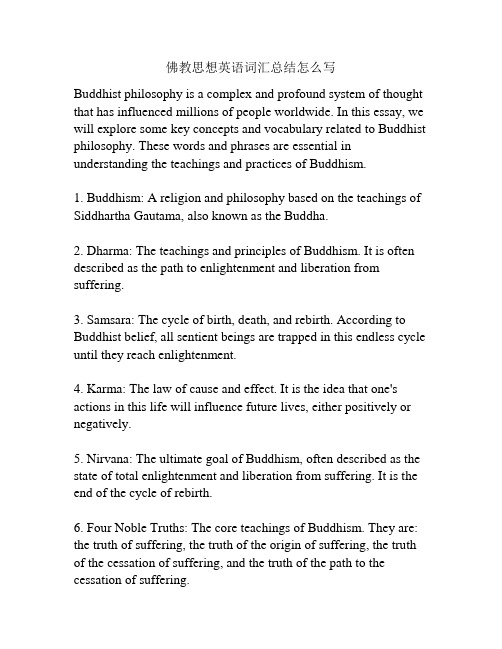
佛教思想英语词汇总结怎么写Buddhist philosophy is a complex and profound system of thought that has influenced millions of people worldwide. In this essay, we will explore some key concepts and vocabulary related to Buddhist philosophy. These words and phrases are essential in understanding the teachings and practices of Buddhism.1. Buddhism: A religion and philosophy based on the teachings of Siddhartha Gautama, also known as the Buddha.2. Dharma: The teachings and principles of Buddhism. It is often described as the path to enlightenment and liberation from suffering.3. Samsara: The cycle of birth, death, and rebirth. According to Buddhist belief, all sentient beings are trapped in this endless cycle until they reach enlightenment.4. Karma: The law of cause and effect. It is the idea that one's actions in this life will influence future lives, either positively or negatively.5. Nirvana: The ultimate goal of Buddhism, often described as the state of total enlightenment and liberation from suffering. It is the end of the cycle of rebirth.6. Four Noble Truths: The core teachings of Buddhism. They are: the truth of suffering, the truth of the origin of suffering, the truth of the cessation of suffering, and the truth of the path to the cessation of suffering.7. Eightfold Path: Also known as the Middle Way, it is the path that leads to the cessation of suffering and the attainment of enlightenment. It consists of eight principles: right view, right intention, right speech, right action, right livelihood, right effort, right mindfulness, and right concentration.8. Bodhisattva: A sentient being who has chosen to postpone their own enlightenment to help others attain liberation. They are seen as compassionate beings who actively work for the benefit of all sentient beings.9. Sangha: The community of Buddhist practitioners. It is often referred to as the monastic community, but can also include lay practitioners.10. Meditation: A practice of calming the mind and developing mindfulness. It is an essential part of Buddhist practice and is believed to be a way to cultivate awareness and gain insight into the nature of reality.11. Compassion: A key virtue emphasized in Buddhism. It is the practice of showing empathy, kindness, and understanding towards oneself and others.12. Non-attachment: The idea of not being attached to material possessions, desires, or outcomes. It is seen as a way to reduce suffering and cultivate wisdom.13. Impermanence: The belief that all phenomena are impermanentand constantly changing. This concept is central to Buddhist philosophy and is often used to explain the nature of suffering.14. Dependent Origination: The theory that all things and phenomena arise and exist due to a complex web of interdependent causes and conditions. It is an important concept in understanding the nature of reality as taught in Buddhism.15. Mindfulness: The practice of being fully present and aware in the present moment. It is a foundational practice in Buddhism and is believed to lead to insight and liberation.In conclusion, Buddhism has a rich and diverse vocabulary that reflects its deep teachings and profound philosophy. This list of words and phrases provides a starting point for exploring the complexities of Buddhist thought, but it is by no means exhaustive. Continued study and practice are necessary to gain a deeper understanding of the teachings and their application in daily life.。
宗教英语词汇大全
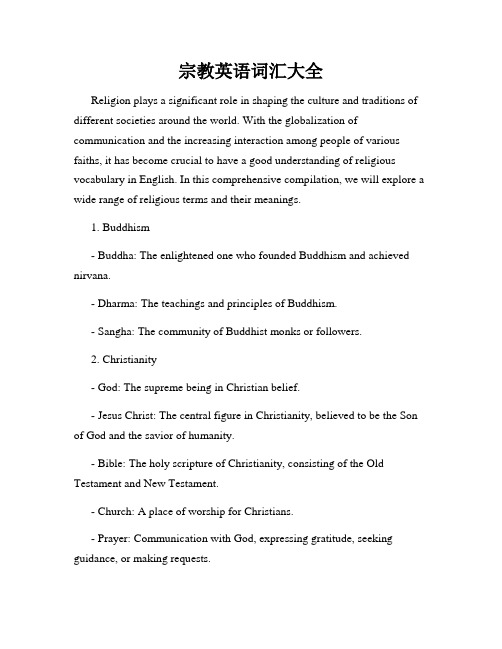
宗教英语词汇大全Religion plays a significant role in shaping the culture and traditions of different societies around the world. With the globalization of communication and the increasing interaction among people of various faiths, it has become crucial to have a good understanding of religious vocabulary in English. In this comprehensive compilation, we will explore a wide range of religious terms and their meanings.1. Buddhism- Buddha: The enlightened one who founded Buddhism and achieved nirvana.- Dharma: The teachings and principles of Buddhism.- Sangha: The community of Buddhist monks or followers.2. Christianity- God: The supreme being in Christian belief.- Jesus Christ: The central figure in Christianity, believed to be the Son of God and the savior of humanity.- Bible: The holy scripture of Christianity, consisting of the Old Testament and New Testament.- Church: A place of worship for Christians.- Prayer: Communication with God, expressing gratitude, seeking guidance, or making requests.3. Islam- Allah: The Arabic term for God in Islam.- Prophet Muhammad: The last and final prophet in Islam, who received the divine revelation of the Quran.- Quran: The holy book of Islam, considered the word of God as revealed to Prophet Muhammad.- Mosque: A place of worship for Muslims.- Ramadan: The ninth month of the Islamic calendar, during which Muslims fast from dawn to sunset.4. Hinduism- Brahma: The creator god in Hinduism.- Shiva: The destroyer god in Hinduism.- Vishnu: The preserver god in Hinduism.- Karma: The law of cause and effect that determines one's destiny based on their actions.- Yoga: A spiritual and physical practice aimed at achieving union with the divine.5. Judaism- Adonai: The Hebrew term for God in Judaism.- Torah: The holy scripture of Judaism, consisting of the first five books of the Old Testament.- Synagogue: A place of worship for Jews.- Rabbi: A Jewish religious leader or teacher.- Kosher: A set of dietary laws and restrictions observed by Jews.6. Sikhism- Guru: A spiritual teacher or guide in Sikhism.- Gurdwara: A place of worship for Sikhs.- Guru Granth Sahib: The holy scripture of Sikhism, considered the eternal guru.- Langar: A communal meal served in Sikh temples, open to all regardless of caste or creed.7. Confucianism- Confucius: The Chinese philosopher who formulated the principles of Confucianism.- Ren: The virtue of benevolence and humaneness in Confucianism.- Junzi: An ideal person who embodies moral integrity and serves as a role model in Confucianism.8. Taoism- Tao: The fundamental principle that governs the universe in Taoism.- Yin and Yang: Complementary forces representing opposites, such as light and dark, in Taoist philosophy.9. Indigenous Religions- Shaman: A spiritual leader who mediates between the human and spirit worlds in indigenous religions.- Ancestor worship: The veneration of deceased ancestors in indigenous belief systems.- Sacred: Something regarded as holy or having spiritual significance in indigenous religions.10. New Age Spirituality- Meditation: A practice of quieting the mind and focusing attention, often used for relaxation and spiritual growth.- Enlightenment: Attaining a higher state of consciousness or understanding in New Age spirituality.In conclusion, this extensive list covers the most commonly used religious terms in English. Understanding and respecting different religious beliefs and practices are essential in fostering harmonious interfaith relationships.。
佛教英语词汇对照总集

佛教英语词汇对照总集(整理ing...)究竟菩提心Absolute Bodhi Citta - 完全觉醒、见到现象之空性的心;甘露Amrta (藏文dut tsi) :一种加持物,能帮助心理及生理疾病的复元。
阿罗汉Arhat (藏文Dra Chompa):已净除烦恼障的小乘修行者暨成就者。
他们是完全了悟的声闻或独觉(或称缘觉)圣者。
观音菩萨AvalOkiteSVara (藏文ChenreZig):大悲心本尊,是西藏人最广为修持的本尊,因此被尊为西藏之怙佑者。
观音菩萨的心咒是「嗡嘛呢贝美吽」,六字大明咒或六字明咒。
中阴(藏文Bardo):字义为「介于两者之间」。
中阴总共有六种,一般指的是介于死亡及再度受生之间的状态。
菩提心Bodhi Citta (藏文Chang Chup Sem):义为「开悟或证悟之心」。
菩萨Bodhi SattVa (藏文Chang Chup Sem Pa):义为「展现证悟心者」,亦指为了救度一切众生脱离轮回苦海,而誓愿修持以菩提心为基础的大乘法门及六波罗蜜的修行者。
菩萨戒Bodhi SattVa Vow (藏文Chang Chup Sem Gyi Dong Pa):修行者为了引领一切众生皆成就佛果而誓愿修行并领受的戒。
佛性Buddha Nature (梵文tathagatagarbha,藏文deshin shekpe nying po),又称为「如来藏」:是一切众生皆具有之原始本性。
开悟就是佛性的彰显,因此,佛性往往被称为佛的本质,或开悟的本质。
释迦牟尼佛Buddha Sakyamuni (藏文Shakya Tubpa):往往又称为瞿昙佛(Gautama Bu ddha),指贤劫千佛当中最近出世、住于公元前五百六十三年至四百八十三年间的佛。
法道Buddhist Path (藏文lam):得到正觉或证悟的过程,亦指修行的三种逻辑次第;根、道、果「」中的道。
圆满次第Completion Stage (藏文dzo rim):在金刚乘,禅修有两个阶段:生起次第及圆满次第。
常见佛教英语
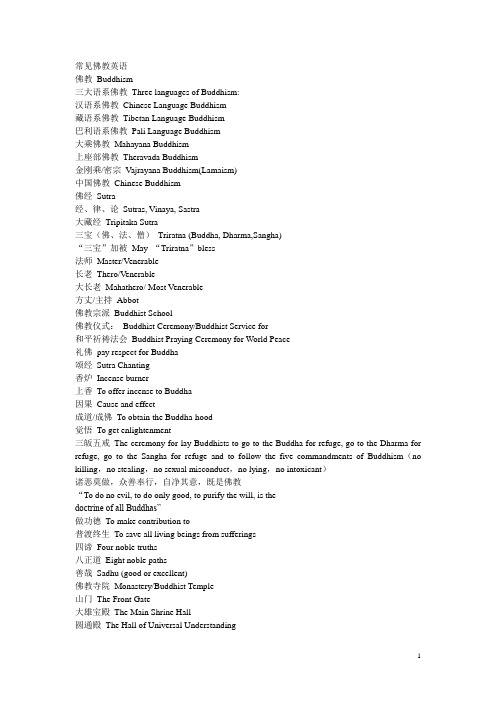
常见佛教英语佛教Buddhism三大语系佛教Three languages of Buddhism:汉语系佛教Chinese Language Buddhism藏语系佛教Tibetan Language Buddhism巴利语系佛教Pali Language Buddhism大乘佛教Mahayana Buddhism上座部佛教Theravada Buddhism金刚乘/密宗Vajrayana Buddhism(Lamaism)中国佛教Chinese Buddhism佛经Sutra经、律、论Sutras, Vinaya, Sastra大藏经Tripitaka Sutra三宝(佛、法、僧)Triratna (Buddha, Dharma,Sangha)“三宝”加被May “Triratna”bless法师Master/Venerable长老Thero/Venerable大长老Mahathero/ Most V enerable方丈/主持Abbot佛教宗派Buddhist School佛教仪式:Buddhist Ceremony/Buddhist Service for和平祈祷法会Buddhist Praying Ceremony for World Peace礼佛pay respect for Buddha颂经Sutra Chanting香炉Incense burner上香To offer incense to Buddha因果Cause and effect成道/成佛To obtain the Buddha-hood觉悟To get enlightenment三皈五戒The ceremony for lay Buddhists to go to the Buddha for refuge, go to the Dharma for refuge, go to the Sangha for refuge and to follow the five commandments of Buddhism(no killing,no stealing,no sexual misconduct,no lying,no intoxicant)诸恶莫做,众善奉行,自净其意,既是佛教“To do no evil, to do only good, to purify the will, is thedoctrine of all Buddhas”做功德To make contribution to普渡终生To save all living beings from sufferings四谛Four noble truths八正道Eight noble paths善哉Sadhu (good or excellent)佛教寺院Monastery/Buddhist Temple山门The Front Gate大雄宝殿The Main Shrine Hall圆通殿The Hall of Universal Understanding观音殿The Hall of Avalokitesvara Buddhisatva藏经阁The Tripitaka Sutra Pavilion罗汉堂The Hall of Arhan祖师殿The Hall of Patriarch四大天王Four deva-kings, the protectors of Buddhism韦驮Vitasoka/Vigatasoka, the protector of Buddhism斋堂Monastic Dinning Hall客堂Monastic Reception四大名山:Four holy mountains of Chinese Buddhism五台山Wutai Mountain is the Holy Place of Manjusri Buddhisattva峨嵋山Ermei Mountain is the Holy Place of Mahasthama Buddhisattva 九华山Jiuhua Mountain is the holy place of Ksitigarbha Buddhisattva 普陀山Putuo Mountain is the holy place of Avalokitesvara Buddhisattva 佛像Buddha statue释迦牟尼佛Shakyamuni Buddha弥勒佛Maitreya Buddha迦叶佛Kasyapa Buddha阿弥陀佛Amitaba Buddha毗庐舍那佛Vairocana Buddha药师佛Bhaisajya Buddha/medicine Buddha三世佛Buddhas of Three Periods:Kasyapa Buddha of the pastShakyamuni Buddha of the present,Maitrya Buddha of the future菩萨Buddhisattva观世音菩萨Avalokitesvara Buddhisattva菩贤菩萨Samandhabatra Buddhisattva大势智菩萨Mahasthamaprapta Buddhisattva文殊菩萨Manjusri Buddisattva地藏菩萨ksitigahba Buddhisattva善财童子Sudhana罗汉Arhan西方三圣:阿弥陀佛、观音菩萨、大势至菩萨Amitaba BuddhaAvalokitesvara BuddhisattvaMahasthamaprapta Buddhisattva达摩Budhidharma摩腾Kasyapa Matanga竺法兰Gobharana/Dharmaraksa佛学院Buddhist College僧伽Sangha僧、尼(比丘、比丘尼)monk、nun /Bhiksu, Bhiksuni方丈/主持Abbot首座Chief monk监院/当家Monastic Manger侍者Assistant中国佛教协会The Buddhist Association of China中国佛学院The Buddhist Academy of China会长President副会长Vice President秘书长Secretary General副秘书长Deputy Secretary General佛学英语词汇the Great Vehicle d大乘the Lesser Vehicle 小乘the Diamond Vehicle 金刚乘Four Noble Truths 四圣谛苦suffering集causes of suffering灭suppression of suffering 道path to suppression of sufferingTwelve Links in the Chain of Causation 十二因缘cycle of rebirths 轮回ignorance 惑nirvana 涅磐greed 贪hatred 嗔stupidity 痴pride 慢hesitation 疑wrong view 恶见no-soul 无我impermanence 无常sentient beings 众生deva 天human 人asura 阿修罗animal 畜牲hungry ghost 饿鬼denizen of hell 地狱morality 戒concentration 定wisdom 慧action 身speech 口consciousness 意lay Buddhists 居士novice monks 沙弥monks 比丘Five Precepts 五戒personal enlightenment 自觉universal enlightenment 觉他full enlightenment 觉满Buddha of Medicine 药师佛Buddha Maitreya 弥勒佛body of essence 法身award body 报身body of transformation 化身Four Heavenly Kings 四天王karma 因果Buddha Amitaba 阿弥陀佛Buddha of Sunlight (法身佛)毗卢遮那佛Buddha Sakyamuni 释迦牟尼佛Bodhisattva of Compassion 观音菩萨Boohisattva of Ultimate Knowledge 文殊菩萨Bodhisattva of Universal Benevolence 普贤菩萨Bodhisattva of Great Power 大势至菩萨bodhi 菩提dhyana 禅那sangha 僧团saha 娑婆五蕴five aggregates色aggregate of material body受aggregate of feelings想aggregate of perceptions 行aggregate of predispositions识aggregate of consciousness简单佛学英语Birth is suffering; aging is suffering;生是苦;老是苦;sickness is suffering; death is suffering;病是苦;死是苦;association with the unpleasant is suffering;怨憎会是苦;dissociation from the pleasant is suffering;爱别离是苦;not to get what one wants is suffering;求不得是苦;in short, attachment to the five aggregates is suffering.简言之,对五蕴的执取就是苦。
佛教相关英语词汇
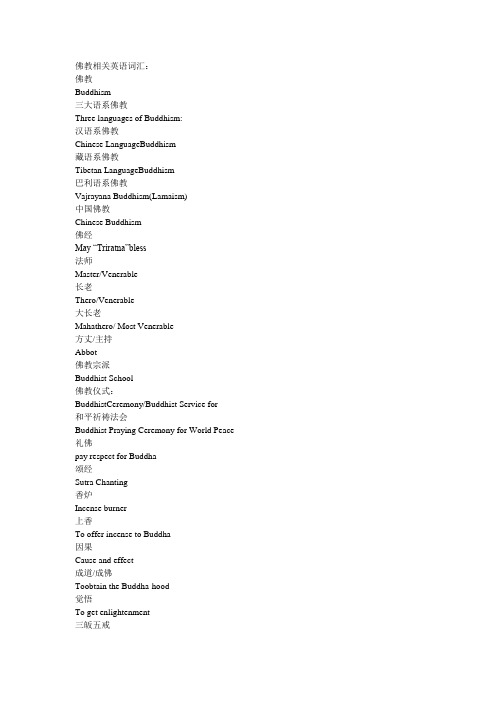
佛教相关英语词汇:佛教Buddhism三大语系佛教Three languages of Buddhism:汉语系佛教Chinese LanguageBuddhism藏语系佛教Tibetan LanguageBuddhism巴利语系佛教Vajrayana Buddhism(Lamaism)中国佛教Chinese Buddhism佛经May “Triratna”bless法师Master/Venerable长老Thero/Venerable大长老Mahathero/ Most Venerable方丈/主持Abbot佛教宗派Buddhist School佛教仪式:BuddhistCeremony/Buddhist Service for和平祈祷法会Buddhist Praying Ceremony for World Peace 礼佛pay respect for Buddha颂经Sutra Chanting香炉Incense burner上香To offer incense to Buddha因果Cause and effect成道/成佛Toobtain the Buddha-hood觉悟To get enlightenment三皈五戒The ceremony for lay Buddhists to go to the Buddha for refuge, goto the Dharma for refuge, go to the Sangha forrefuge and to follow the five commandments of Buddhism(no killing,no stealing,no sexualmisconduct,no lying,no intoxicant)诸恶莫做,众善奉行,自净其意,既是佛教“To do no evil, to do only good, to purify the will, is thedoctrine of all Buddhas”做功德To make contribution to普渡终生To save all living beings from sufferingsAmitabha 阿弥陀佛Avalokiteshvara 观音Bhodisattva 菩萨释迦牟尼佛Buddha Sakyamuni观音菩萨AvalOkiteSVaraffinities 因缘* (with emphasis on good relationships)All living beings have the Buddha-nature; all can become Buddhas. 一切众生,皆有佛性,皆堪作佛。
佛教英汉对照词典词语列表
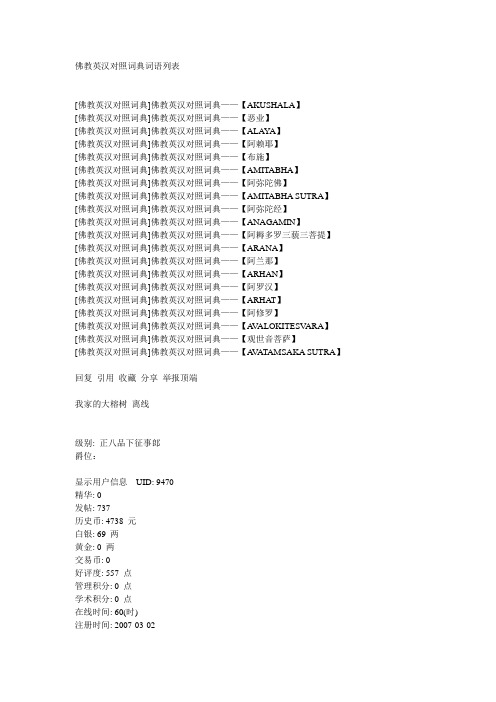
佛教英汉对照词典词语列表[佛教英汉对照词典]佛教英汉对照词典——【AKUSHALA】[佛教英汉对照词典]佛教英汉对照词典——【恶业】[佛教英汉对照词典]佛教英汉对照词典——【ALAYA】[佛教英汉对照词典]佛教英汉对照词典——【阿赖耶】[佛教英汉对照词典]佛教英汉对照词典——【布施】[佛教英汉对照词典]佛教英汉对照词典——【AMITABHA】[佛教英汉对照词典]佛教英汉对照词典——【阿弥陀佛】[佛教英汉对照词典]佛教英汉对照词典——【AMITABHA SUTRA】[佛教英汉对照词典]佛教英汉对照词典——【阿弥陀经】[佛教英汉对照词典]佛教英汉对照词典——【ANAGAMIN】[佛教英汉对照词典]佛教英汉对照词典——【阿耨多罗三藐三菩提】[佛教英汉对照词典]佛教英汉对照词典——【ARANA】[佛教英汉对照词典]佛教英汉对照词典——【阿兰那】[佛教英汉对照词典]佛教英汉对照词典——【ARHAN】[佛教英汉对照词典]佛教英汉对照词典——【阿罗汉】[佛教英汉对照词典]佛教英汉对照词典——【ARHAT】[佛教英汉对照词典]佛教英汉对照词典——【阿修罗】[佛教英汉对照词典]佛教英汉对照词典——【A V ALOKITESV ARA】[佛教英汉对照词典]佛教英汉对照词典——【观世音菩萨】[佛教英汉对照词典]佛教英汉对照词典——【A V ATAMSAKA SUTRA】回复引用收藏分享举报顶端我家的大榕树离线级别: 正八品下征事郎爵位:显示用户信息UID: 9470精华: 0发帖: 737历史币: 4738 元白银: 69 两黄金: 0 两交易币: 0好评度: 557 点管理积分: 0 点学术积分: 0 点在线时间: 60(时)注册时间: 2007-03-02最后登录: 2009-04-13 沙发发表于: 2008-07-07 只看该作者┊小中大[佛教英汉对照词典]佛教英汉对照词典——【华严经】[佛教英汉对照词典]佛教英汉对照词典——【BHAISAJY AGURU】[佛教英汉对照词典]佛教英汉对照词典——【药师佛】[佛教英汉对照词典]佛教英汉对照词典——【BHIKSU】[佛教英汉对照词典]佛教英汉对照词典——【比丘】[佛教英汉对照词典]佛教英汉对照词典——【BHIKSUNI】[佛教英汉对照词典]佛教英汉对照词典——【比丘尼】[佛教英汉对照词典]佛教英汉对照词典——【BODHISATTV A】[佛教英汉对照词典]佛教英汉对照词典——【菩萨】[佛教英汉对照词典]佛教英汉对照词典——【BRAHMIN】[佛教英汉对照词典]佛教英汉对照词典——【BRAHMIN】[佛教英汉对照词典]佛教英汉对照词典——【BRAHMIN】[佛教英汉对照词典]佛教英汉对照词典——【佛】[佛教英汉对照词典]佛教英汉对照词典——【BURNING LAMP BUDDHA】[佛教英汉对照词典]佛教英汉对照词典——【燃灯佛】[佛教英汉对照词典]佛教英汉对照词典——【CHAN】[佛教英汉对照词典]佛教英汉对照词典——【禅】[佛教英汉对照词典]佛教英汉对照词典——【CHARITY】[佛教英汉对照词典]佛教英汉对照词典——【布施】[佛教英汉对照词典]佛教英汉对照词典——【CONDITION】回复引用分享举报顶端我家的大榕树离线级别: 正八品下征事郎爵位:显示用户信息UID: 9470精华: 0发帖: 737历史币: 4738 元白银: 69 两黄金: 0 两交易币: 0好评度: 557 点管理积分: 0 点学术积分: 0 点在线时间: 60(时)注册时间: 2007-03-02最后登录: 2009-04-13 板凳发表于: 2008-07-07 只看该作者┊小中大[佛教英汉对照词典]佛教英汉对照词典——【缘】[佛教英汉对照词典]佛教英汉对照词典——【CONTEMPLATION】[佛教英汉对照词典]佛教英汉对照词典——【观想】[佛教英汉对照词典]佛教英汉对照词典——【DIVINE EYE】[佛教英汉对照词典]佛教英汉对照词典——【天眼】[佛教英汉对照词典]佛教英汉对照词典——【DEVOTION】[佛教英汉对照词典]佛教英汉对照词典——【精进】[佛教英汉对照词典]佛教英汉对照词典——【DHAMMAPADA】[佛教英汉对照词典]佛教英汉对照词典——【法句经】[佛教英汉对照词典]佛教英汉对照词典——【DHARMA】[佛教英汉对照词典]佛教英汉对照词典——【法】[佛教英汉对照词典]佛教英汉对照词典——【DHARMA-WHEEL】[佛教英汉对照词典]佛教英汉对照词典——【***】[佛教英汉对照词典]佛教英汉对照词典——【DV ADASHAMUKHA SHASTRA】[佛教英汉对照词典]佛教英汉对照词典——【十二门论】[佛教英汉对照词典]佛教英汉对照词典——【EFFORT】[佛教英汉对照词典]佛教英汉对照词典——【精进】[佛教英汉对照词典]佛教英汉对照词典——【EIGHT DIVISIONS OF GODS AND DRAGONS】[佛教英汉对照词典]佛教英汉对照词典——【天龙八部】[佛教英汉对照词典]佛教英汉对照词典——【EIGHT NEGATIONS】回复引用分享举报顶端我家的大榕树离线级别: 正八品下征事郎爵位:显示用户信息UID: 9470精华: 0发帖: 737历史币: 4738 元白银: 69 两黄金: 0 两交易币: 0好评度: 557 点管理积分: 0 点学术积分: 0 点在线时间: 60(时)注册时间: 2007-03-02最后登录: 2009-04-13 3 发表于: 2008-07-07 只看该作者┊小中大[佛教英汉对照词典]佛教英汉对照词典——【DEVOTION】[佛教英汉对照词典]佛教英汉对照词典——【精进】[佛教英汉对照词典]佛教英汉对照词典——【DHAMMAPADA】[佛教英汉对照词典]佛教英汉对照词典——【法句经】[佛教英汉对照词典]佛教英汉对照词典——【DHARMA】[佛教英汉对照词典]佛教英汉对照词典——【法】[佛教英汉对照词典]佛教英汉对照词典——【DHARMA-WHEEL】[佛教英汉对照词典]佛教英汉对照词典——【***】[佛教英汉对照词典]佛教英汉对照词典——【DV ADASHAMUKHA SHASTRA】[佛教英汉对照词典]佛教英汉对照词典——【十二门论】[佛教英汉对照词典]佛教英汉对照词典——【EFFORT】[佛教英汉对照词典]佛教英汉对照词典——【精进】[佛教英汉对照词典]佛教英汉对照词典——【EIGHT DIVISIONS OF GODS AND DRAGONS】[佛教英汉对照词典]佛教英汉对照词典——【天龙八部】[佛教英汉对照词典]佛教英汉对照词典——【EIGHT NEGATIONS】[佛教英汉对照词典]佛教英汉对照词典——【八不】[佛教英汉对照词典]佛教英汉对照词典——【EIGHT SUFFERINGS】[佛教英汉对照词典]佛教英汉对照词典——【八苦】[佛教英汉对照词典]佛教英汉对照词典——【EIGHT WINDS】[佛教英汉对照词典]佛教英汉对照词典——【八风】回复引用分享举报顶端我家的大榕树离线级别: 正八品下征事郎爵位:显示用户信息UID: 9470精华: 0发帖: 737历史币: 4738 元白银: 69 两黄金: 0 两交易币: 0好评度: 557 点管理积分: 0 点学术积分: 0 点在线时间: 60(时)注册时间: 2007-03-02最后登录: 2009-04-13 4 发表于: 2008-07-07 只看该作者┊小中大[佛教英汉对照词典]佛教英汉对照词典——【EIGHTEEN DIFFERENT CHARACTERS】[佛教英汉对照词典]佛教英汉对照词典——【十八不共法】[佛教英汉对照词典]佛教英汉对照词典——【EIGHTEEN FIELDS】[佛教英汉对照词典]佛教英汉对照词典——【十八界】[佛教英汉对照词典]佛教英汉对照词典——【EIGHTFOLD PATH】[佛教英汉对照词典]佛教英汉对照词典——【八正道】[佛教英汉对照词典]佛教英汉对照词典——【EMPTINESS】[佛教英汉对照词典]佛教英汉对照词典——【空】[佛教英汉对照词典]佛教英汉对照词典——【ENDURANCE】[佛教英汉对照词典]佛教英汉对照词典——【忍辱】[佛教英汉对照词典]佛教英汉对照词典——【ENERGY】[佛教英汉对照词典]佛教英汉对照词典——【精进】[佛教英汉对照词典]佛教英汉对照词典——【ENLIGHTENMENT】[佛教英汉对照词典]佛教英汉对照词典——【觉悟】[佛教英汉对照词典]佛教英汉对照词典——【EVIL TIME OF FIVE TURBIDITIES】[佛教英汉对照词典]佛教英汉对照词典——【五浊恶世】[佛教英汉对照词典]佛教英汉对照词典——【EXTINCTION】[佛教英汉对照词典]佛教英汉对照词典——【灭度】[佛教英汉对照词典]佛教英汉对照词典——【FIVE BASIC AFFLICATIONS】[佛教英汉对照词典]佛教英汉对照词典——【五根本烦恼】回复引用分享举报顶端我家的大榕树离线级别: 正八品下征事郎爵位:显示用户信息UID: 9470精华: 0发帖: 737历史币: 4738 元白银: 69 两黄金: 0 两交易币: 0好评度: 557 点管理积分: 0 点学术积分: 0 点在线时间: 60(时)注册时间: 2007-03-02最后登录: 2009-04-13 5 发表于: 2008-07-07 只看该作者┊小中大[佛教英汉对照词典]佛教英汉对照词典——【FIVE BHIKSHUS】[佛教英汉对照词典]佛教英汉对照词典——【五比丘】[佛教英汉对照词典]佛教英汉对照词典——【FIVE CATEGORIES OF UNTRANSLATED TERMS】[佛教英汉对照词典]佛教英汉对照词典——【五不翻】[佛教英汉对照词典]佛教英汉对照词典——【FIVE COMMANDMENTS】[佛教英汉对照词典]佛教英汉对照词典——【五戒】[佛教英汉对照词典]佛教英汉对照词典——【FIVE EYES】[佛教英汉对照词典]佛教英汉对照词典——【五眼(肉眼、天眼、法眼、慧眼、佛眼)】[佛教英汉对照词典]佛教英汉对照词典——【五眼(肉眼、天眼、法眼、慧眼、佛眼)】[佛教英汉对照词典]佛教英汉对照词典——【五衰】[佛教英汉对照词典]佛教英汉对照词典——【FIVE MESSENGERS】[佛教英汉对照词典]佛教英汉对照词典——【五使者】[佛教英汉对照词典]佛教英汉对照词典——【FIVE OFFENCES】[佛教英汉对照词典]佛教英汉对照词典——【五逆罪】[佛教英汉对照词典]佛教英汉对照词典——【FIVE PRECEPTS】[佛教英汉对照词典]佛教英汉对照词典——【五戒】[佛教英汉对照词典]佛教英汉对照词典——【FIVE SKANDHAS】[佛教英汉对照词典]佛教英汉对照词典——【五蕴】[佛教英汉对照词典]佛教英汉对照词典——【FIVE VEHICLES】[佛教英汉对照词典]佛教英汉对照词典——【五乘】回复引用分享举报顶端我家的大榕树离线级别: 正八品下征事郎爵位:显示用户信息UID: 9470精华: 0发帖: 737历史币: 4738 元白银: 69 两黄金: 0 两交易币: 0好评度: 557 点管理积分: 0 点学术积分: 0 点在线时间: 60(时)注册时间: 2007-03-02最后登录: 2009-04-13 6 发表于: 2008-07-07 只看该作者┊小中大[佛教英汉对照词典]佛教英汉对照词典——【FIVE WISDOMS】[佛教英汉对照词典]佛教英汉对照词典——【五智】[佛教英汉对照词典]佛教英汉对照词典——【FLOWER ADORNMENT SUTRA】[佛教英汉对照词典]佛教英汉对照词典——【华严经】[佛教英汉对照词典]佛教英汉对照词典——【FOREMOST PARAMITA】[佛教英汉对照词典]佛教英汉对照词典——【第一波罗蜜】[佛教英汉对照词典]佛教英汉对照词典——【FOUR ASPECTS (OF BUDDHIST DHARMA)】[佛教英汉对照词典]佛教英汉对照词典——【四法】[佛教英汉对照词典]佛教英汉对照词典——【FOUR FEARLESSNESS】[佛教英汉对照词典]佛教英汉对照词典——【四无所畏】[佛教英汉对照词典]佛教英汉对照词典——【FOUR FRUITION】[佛教英汉对照词典]佛教英汉对照词典——【四果】[佛教英汉对照词典]佛教英汉对照词典——【FOUR GREAT BODHISATTV A】[佛教英汉对照词典]佛教英汉对照词典——【四大菩萨】[佛教英汉对照词典]佛教英汉对照词典——【FOUR GREAT ELEMENTS】[佛教英汉对照词典]佛教英汉对照词典——【四大】[佛教英汉对照词典]佛教英汉对照词典——【FOUR GREAT VOWS】[佛教英汉对照词典]佛教英汉对照词典——【四弘誓愿】[佛教英汉对照词典]佛教英汉对照词典——【FOUR HOL Y REALMS】[佛教英汉对照词典]佛教英汉对照词典——【四圣道】回复引用分享举报顶端我家的大榕树离线级别: 正八品下征事郎爵位:显示用户信息UID: 9470精华: 0发帖: 737历史币: 4738 元白银: 69 两黄金: 0 两交易币: 0好评度: 557 点管理积分: 0 点学术积分: 0 点在线时间: 60(时)注册时间: 2007-03-02最后登录: 2009-04-13 7 发表于: 2008-07-07 只看该作者┊小中大[佛教英汉对照词典]佛教英汉对照词典——【FOUR IMMEASURABLE MINDS】[佛教英汉对照词典]佛教英汉对照词典——【四无量】[佛教英汉对照词典]佛教英汉对照词典——【FOUR NOBLE TRUTHS】[佛教英汉对照词典]佛教英汉对照词典——【四圣谛】[佛教英汉对照词典]佛教英汉对照词典——【FOUR PHALA】[佛教英汉对照词典]佛教英汉对照词典——【四果】[佛教英汉对照词典]佛教英汉对照词典——【FOUR RELIANCE 】[佛教英汉对照词典]佛教英汉对照词典——【四依】[佛教英汉对照词典]佛教英汉对照词典——【FOUR SEALS】[佛教英汉对照词典]佛教英汉对照词典——【四法印】[佛教英汉对照词典]佛教英汉对照词典——【FOUR UNLIMITED MIND】[佛教英汉对照词典]佛教英汉对照词典——【四无量心】[佛教英汉对照词典]佛教英汉对照词典——【FOUR VIRTUES】[佛教英汉对照词典]佛教英汉对照词典——【四德】[佛教英汉对照词典]佛教英汉对照词典——【FOUR WAYS 】[佛教英汉对照词典]佛教英汉对照词典——【四法】[佛教英汉对照词典]佛教英汉对照词典——【FOURFOLD ASSEMBL Y】[佛教英汉对照词典]佛教英汉对照词典——【四众】[佛教英汉对照词典]佛教英汉对照词典——【GIVING】[佛教英汉对照词典]佛教英汉对照词典——【布施】回复引用分享举报顶端我家的大榕树离线级别: 正八品下征事郎爵位:显示用户信息UID: 9470精华: 0发帖: 737历史币: 4738 元白银: 69 两黄金: 0 两交易币: 0好评度: 557 点管理积分: 0 点学术积分: 0 点在线时间: 60(时)注册时间: 2007-03-02最后登录: 2009-04-13 8 发表于: 2008-07-07 只看该作者┊小中大佛教英汉对照词典词语列表[佛教英汉对照词典]佛教英汉对照词典——【HEA VENL Y EYE】[佛教英汉对照词典]佛教英汉对照词典——【天眼】[佛教英汉对照词典]佛教英汉对照词典——【HINAY ANA】[佛教英汉对照词典]佛教英汉对照词典——【小乘】[佛教英汉对照词典]佛教英汉对照词典——【HSU YUN】[佛教英汉对照词典]佛教英汉对照词典——【虚云】[佛教英汉对照词典]佛教英汉对照词典——【HUA TOU】[佛教英汉对照词典]佛教英汉对照词典——【话头】[佛教英汉对照词典]佛教英汉对照词典——【HUI NENG】[佛教英汉对照词典]佛教英汉对照词典——【惠能】[佛教英汉对照词典]佛教英汉对照词典——【IGNORANCE】[佛教英汉对照词典]佛教英汉对照词典——【无明】[佛教英汉对照词典]佛教英汉对照词典——【JA TAKA】[佛教英汉对照词典]佛教英汉对照词典——【本生经】[佛教英汉对照词典]佛教英汉对照词典——【KARMA】[佛教英汉对照词典]佛教英汉对照词典——【业】[佛教英汉对照词典]佛教英汉对照词典——【KSATRIYA】[佛教英汉对照词典]佛教英汉对照词典——【刹帝利】[佛教英汉对照词典]佛教英汉对照词典——【KUSHALA】[佛教英汉对照词典]佛教英汉对照词典——【善业】回复引用分享举报顶端我家的大榕树离线级别: 正八品下征事郎爵位:显示用户信息UID: 9470精华: 0发帖: 737历史币: 4738 元白银: 69 两黄金: 0 两交易币: 0好评度: 557 点管理积分: 0 点学术积分: 0 点在线时间: 60(时)注册时间: 2007-03-02最后登录: 2009-04-13 9 发表于: 2008-07-07 只看该作者┊小中大[佛教英汉对照词典]佛教英汉对照词典——【LAW】[佛教英汉对照词典]佛教英汉对照词典——【理】[佛教英汉对照词典]佛教英汉对照词典——【LAW OF DEPENDENT ORIGINA TION】[佛教英汉对照词典]佛教英汉对照词典——【缘起法】[佛教英汉对照词典]佛教英汉对照词典——【LOTUS SUTRA】[佛教英汉对照词典]佛教英汉对照词典——【妙法莲华经】[佛教英汉对照词典]佛教英汉对照词典——【MAHAMAYA】[佛教英汉对照词典]佛教英汉对照词典——【摩诃摩耶夫人】[佛教英汉对照词典]佛教英汉对照词典——【MAHA-PRAJNA-PARAMITA-SUTRA】[佛教英汉对照词典]佛教英汉对照词典——【大般若经】[佛教英汉对照词典]佛教英汉对照词典——【MAHASATTVA】[佛教英汉对照词典]佛教英汉对照词典——【摩诃萨】[佛教英汉对照词典]佛教英汉对照词典——【MAHAY ANA】[佛教英汉对照词典]佛教英汉对照词典——【大乘】[佛教英汉对照词典]佛教英汉对照词典——【MAITREYA】[佛教英汉对照词典]佛教英汉对照词典——【弥勒菩萨】[佛教英汉对照词典]佛教英汉对照词典——【MANJUSRI BODHISATTV A】[佛教英汉对照词典]佛教英汉对照词典——【文殊菩萨】[佛教英汉对照词典]佛教英汉对照词典——【MANTRA】[佛教英汉对照词典]佛教英汉对照词典——【咒】您正在看的文章来自历史帝国,原文地址:/read.php?tid=68616。
佛教专用词汇英语

Ananda 阿難One of the Shakyamuni Buddha's Ten Great Disciples. He was first in hearing the Buddha's words. As he had excellent memory, he memorized the Buddha's sermons, which were later recorded as sutras. He was also the cousin of Shakyamuni Buddha。
Arhat 阿羅漢Arhat in Sanskrit, Arahat in Pali. Literally, man of worth, honourable one. There are two kinds of arhats, namely, the Sound-hearing arhat (Sravaka) and the Enlightened-to-condition arhat (Praetyka-Buddha). The former attains the wisdom to understand the Four Noble Truth, while the latter attains the wisdom to understand the Law of Dependent Origination or the Twelve Links of Dependent Origination. They represent two vehicles, who "comprehend for their own sake". As they pay attention to themselves and not to others, they are incapable of genuine and equal enlightenment. There are four noble stages of fruition in the Arhat Path.。
佛教英语术语

“觉悟To get enlightenmentconsciousness/awareness佛教Buddhism三大语系佛教Three languages of Buddhism:汉语系佛教Chinese LanguageBuddhism藏语系佛教Tibetan LanguageBuddhism巴利语系佛教Pali Language Buddhism大乘佛教MahayanaBuddhism上座部佛教Theravada Buddhism金刚乘/密宗V ajrayana Buddhism(Lamaism)中国佛教Chinese Buddhism佛经Sutra经、律、论Sutras, V inaya,Sastra大藏经TripitakaSutra三宝(佛、法、僧)Triratna (Buddha, Dharma,Sangha)“三宝”加被May “Triratna”bless法师Master/V enerable长老Thero/V enerable大长老Mahathero/ Most V enerable方丈/主持Abbot佛教宗派Buddhist School佛教仪式:BuddhistCeremony/Buddhist Service for和平祈祷法会Buddhist Praying Ceremony for World Peace礼佛pay respect for Buddha颂经Sutra Chanting香炉Incense burner上香To offer incense to Buddha因果Cause and effect成道/成佛Toobtain the Buddha-hood觉悟To get enlightenment三皈五戒Theceremony for lay Buddhists to go to the Buddha for refuge, go tothe Dharma for refuge, go to the Sangha forrefuge and to follow the fivecommandments of Buddhism(no killing,no stealing,no sexualmisconduct,no lying,no intoxicant)诸恶莫做,众善奉行,自净其意,既是佛教“To do no evil, to do only good, to purify the will, is thedoctrine of all Buddhas”做功德To make contribution to普渡终生To save all living beings from sufferings四谛Fournoble truths八正道Eightnoblepaths善哉Sadhu(good or excellent)佛教寺院Monastery/Buddhist Temple山门The Front Gate大雄宝殿The Main Shrine Hall圆通殿The Hall of Universal Understanding观音殿The Hall of A valokitesvara Buddhisatva藏经阁The Tripitaka Sutra Pavilion罗汉堂The Hall of Arhan祖师殿The Hall of Patriarch四大天王Four deva-kings, the protectors of Buddhism韦驮V itasoka/Vigatasoka, the protector ofBuddhism斋堂Monastic Dinning Hall客堂Monastic Reception四大名山:Four holy mountains ofChinese Buddhism五台山WutaiMountain is the Holy Place of Manjusri Buddhisattva峨嵋山ErmeiMountain is the Holy Place of Mahasthama Buddhisattva 九华山JiuhuaMountain is the holy place of Ksitigarbha Buddhisattva 普陀山PutuoMountain is the holy place of A valokitesvara Buddhisattva 佛像Buddha statue释迦牟尼佛Shakyamuni Buddha弥勒佛Maitreya Buddha迦叶佛Kasyapa Buddha阿弥陀佛Amitaba Buddha毗庐舍那佛V airocana Buddha药师佛BhaisajyaBuddha/medicine Buddha三世佛Buddhasof Three Periods:Kasyapa Buddha of the pastShakyamuni Buddha of the present,Maitrya Buddha of the future菩萨Buddhisattva观世音菩萨A valokitesvaraBuddhisattva菩贤菩萨SamandhabatraBuddhisattva大势智菩萨MahasthamapraptaBuddhisattva文殊菩萨Manjusri Buddisattva地藏菩萨ksitigahba Buddhisattva善财童子Sudhana罗汉Arhan西方三圣:阿弥陀佛、观音菩萨、大势至菩萨Amitaba BuddhaA valokitesvara BuddhisattvaMahasthamaprapta Buddhisattva达摩Budhidharma摩腾KasyapaMatanga竺法兰Gobharana/Dharmaraksa佛学院BuddhistCollege僧伽Sangha僧、尼(比丘、比丘尼)monk、nun /Bhiksu, Bhiksuni方丈/主持Abbot首座Chief monk监院/当家Monastic Manger侍者Assistant中国佛教协会The Buddhist Association of China中国佛学院TheBuddhist Academy of China会长President副会长V ice President秘书长Secretary General副秘书长Deputy Secretary General任持自性、轨生物解retaining its own nature,such that it can berecognized正觉enlightenment 等觉或遍觉erfect enlightenment圆觉或无上觉supreme or paramountenlingtenment一切众生,皆有佛性,有佛性者,皆得成佛All living beings have Buddha-nature ,everyone with theBuddha-nuture may attain Buddhahood.缘起dependent origination八正道the Noble Eightfold Paththe self-same manner 不变的“我”,恒常的我。
佛教中英词汇对照

AKUSHALA 2 恶业 3 ALAYA 4 阿赖耶5 ALMSGIVING6 布施7 AMITABHA8 阿弥陀佛9 AMITABHA SUTRA 10 阿弥陀经 11 ANAGAMIN 12 阿那含13 ANNUTARA-SAMYAK-SAMBODHI 14 阿耨多罗三藐三菩提 15 ARANA 16 阿兰那17 ARHAN 18 阿罗汉 19 ARHAT 20 阿罗汉21 ASURA 22 阿修罗 23 AVALOKITESVARA 24 观世音菩萨25 AVATAMSAKA SUTRA 26 华严经 27 BHAISAJYAGURU 28 药师佛29 BHIKSU 30 比丘 31 BHIKSUNI 32 比丘尼33 BODHISATTVA 34 菩萨 35 BRAHMIN 36 婆罗门37 BUDDHA 38 佛 39 BURNING LAMP BUDDHA 40 燃灯佛41 CHAN 42 禅 43 CHARITY 44 布施45 CONDITION 46 缘 47 CONTEMPLATION 48 观想49 DIVINE EYE 50 天眼 51 DEVOTION 52 精进53 DHAMMAPADA 54 法句经 55 DHARMA 56 法57 DHARMA-WHEEL 58 法轮 59 DVADASHAMUKHA SHASTRA 60 十二门论61 EFFORT 62 精进 63 EIGHT DIVISIONS OF GODS AND DRAGONS 64 天龙八部65 EIGHT NEGATIONS 66 八不 67 EIGHT SUFFERINGS 68 八苦69 EIGHT WINDS 70 八风 71 EIGHTEEN DIFFERENT CHARACTERS 72 十八不共法73 EIGHTEEN FIELDS 74 十八界 75 EIGHTFOLD PATH 76 八正道77 EMPTINESS 78 空 79 ENDURANCE 80 忍辱81 ENERGY 82 精进 83 ENLIGHTENMENT 84 觉悟85 EVIL TIME OF FIVE TURBIDITIES 86 五浊恶世 87 EXTINCTION 88 灭度89 FIVE BASIC AFFLICATIONS 90 五根本烦恼 91 FIVE BHIKSHUS 92 五比丘93 FIVE CATEGORIES OF UNTRANSLATED TERMS 94 五不翻 95 FIVE COMMANDMENTS 96 五戒97 FIVE EYES 98 五眼(肉眼、天眼、法眼、慧眼、佛眼) 99 FIVE FORMS OF DECAYING 100 五衰101 FIVE MESSENGERS 102 五使者 103 FIVE OFFENCES 104 五逆罪(杀父、杀母、杀阿罗汉、出佛身血、破和合僧)105 FIVE PRECEPTS 106 五戒(不杀、不盗、不邪淫、不妄语、不饮酒) 107 FIVE SKANDHAS 108 五蕴109 FIVE VEHICLES 110 五乘(人、天、声闻、缘觉、菩萨) 111 FIVE WISDOMS 112 五智113 FLOWER ADORNMENT SUTRA 114 华严经 115 FOREMOST PARAMITA 116 第一波罗蜜117 FOUR ASPECTS (OF BUDDHIST DHARMA) 118 四法 119 FOUR FEARLESSNESS 120 四无所畏(佛四无所畏,菩萨四无所畏)121 FOUR FRUITION 122 四果 123 FOUR GREAT BODHISATTVA 124 四大菩萨125 FOUR GREAT ELEMENTS 126 四大 127 FOUR GREAT VOWS 128 四弘誓愿129 FOUR HOLY REALMS 130 四圣道 131 FOUR IMMEASURABLE MINDS 132 四无量133 FOUR NOBLE TRUTHS 134 四圣谛 135 FOUR PHALA 136 四果137 FOUR RELIANCE (TO LEARNING BUDDHIST DHARMA) 138 四依 139 FOUR SEALS 140 四法印141 FOUR UNLIMITED MIND 142 四无量心 143 FOUR VIRTUES 144 四德145 FOUR WAYS (OF LEARNING BUDDHIST DHARMA) 146 四法 147 FOURFOLD ASSEMBLY 148 四众149 GIVING 150 布施 151 HEAVENLY EYE 152 天眼153 HINAYANA 154 小乘 155 HSU YUN 156 虚云157 HUA TOU 158 话头 159 HUI NENG 160 惠能161 IGNORANCE 162 无明 163 JATAKA 164 本生经165 KARMA 166 业 167 KSATRIYA 168 刹帝利169 KUSHALA 170 善业 171 LAW 172 理173 LAW OF DEPENDENT ORIGINATION 174 缘起法 175 LOTUS SUTRA 176 妙法莲华经177 MAHAMAYA 178 摩诃摩耶夫人 179 MAHA-PRAJNA-PARAMITA-SUTRA 180 大般若经181 MAHASATTVA 182 摩诃萨 183 MAHAYANA 184 大乘185 MAITREYA 186 弥勒菩萨 187 MANJUSRI BODHISATTVA 188 文殊菩萨189 MANTRA 190 咒 191 MARK 192 相193 MATTER 194 色 195 MEDITATION 196 静虑197 MIDDLE PATH 198 中道 199 MIDDLE WAY 200 中道201 MORALITY 202 持戒 203 NAGARJUNA 204 龙树菩萨205 NINE REALMS 206 九界 207 NINE STAGES OF LOTUS FLOWERS 208 九品莲花209 NIRVANA 210 涅槃 211 NIRVANA OF PURE, CLEAR SELF-NATURE 212 自性涅槃213 NIRVANA WITH RESIDUE 214 有余涅槃 215 NIRVANA WITHOUT RESIDUE 216 无余涅槃217 NIRVANA OF NO DWELLING 218 无住涅槃 219 NO STRIFE SAMADHI 220 无诤三昧221 ONE BUDDHA VEHICLE 222 一佛乘 223 PARAMITA 224 波罗蜜多225 PARINIRVANA 226 圆寂 227 PATIENCE 228 忍辱229 PRATYEKA-BUDDHA 230 辟支佛 231 PRAJNA 232 般若233 PURE LAND 234 净土 235 PURE LAND OF ULTIMATE BLISS 236 极乐世界/净土237 RAHULA 238 罗候罗 239 RAKSA 240 罗刹241 REALM OF FORM 242 色界 243 REALM OF FORMLESSNESS 244 无色界245 REALM OF SENSUOUS DESIRE 246 欲界 247 RECOGNITION 248 想249 RENUNCIATION 250 舍 251 RIGHT ACTION 252 正行253 RIGHT CONCENTRATION 254 正定 255 RIGHT EFFORT 256 正精进257 RIGHT LIVELIHOOD 258 正命 259 RIGHT REMEMBRANCE 260 正念261 RIGHT SPEECH 262 正语 263 RIGHT THOUGHT 264 正思维265 RIGHT UNDERSTANDING 266 正见 267 RIGHT VIEW 268 正见269 RUPA 270 色 271 SAHA LAND 272 娑婆世界273 SAKRADAGAMIN 274 斯陀含 275 SAMADHI 276 三摩地277 SAMANTABHADRA BODHISATTVA 278 普贤菩萨 279 SAMSARA 280 轮回转世281 SAMSKARA 282 行 283 SANJNA 284 想285 SARIPUTRA 286 舍利弗 287 SATYASIDDHI SHASTRA 288 成实论289 SENSATION 290 受 291 SEVEN GEMS 292 七宝【金、银、琉璃、玛瑙、珍珠、玫瑰、砗磲(一种贝壳);或金、银、琉璃、水晶、琥珀、红珍珠、玛瑙】293 SHAKYAMUNI 294 释迦牟尼 295 SHATIKA SHASTRA 296 百论297 SIDDHARTHA GOUTAMA 298 乔达摩·悉达多 299 SINGALOVADA SUTRA 300 善生经301 SIX CONSCIOUSNESS 302 六识 303 SIX DIRECTIONS OF REINCARNATION304 六道轮回305 SIX DUSTS 306 六尘 307 SIX ENTRANCES 308 六入309 SIX EXTERNAL BASES 310 六外处 311 SIX FIELDS OF SENSES 312 六尘313 SIX FULFILMENT 314 六成就(佛经开卷的内容:如是、我闻、说法的时间、说法人、地点、听众) 315 SIX GUNAS 316 六尘317 SIX HEAVENS OF DESIRE 318 六欲天 319 SIX INDRIYAS 320 六根321 SIX INTERNAL BASES 322 六内处 323 SIX PARAMITA 324 六波罗蜜多,六度325 SIX PATHS 326 六道 327 SIX PERIODS OF DAY AND NIGHT 328 六时329 SIX PLACES 330 六根 331 SIX PSYCHIC POWER 332 六神通(天眼通、天耳通、宿命通、他心通、神足通、漏尽通)333 SIX ROOTS 334 六根 335 SIX SENSE-ORGANS 336 六根337 SIX STATES OF EXISTENCE 338 六道 339 SIXTEEN CONTEMPLATIONS 340 十六观经341 SPHERE OF NEITHER-PERCEPTION-NOR-NON-PERCEPTION 342 非想非非想天343 SPHERE OF NO-THING 344 无色天345 SPIRITUAL GHOST 346 鬼神 347 SRAVAKA 348 声闻349 SROTA-APANNA 350 须陀洹 351 STUPA 352 塔353 SUDDEN ENLIGHTENMENT 354 顿悟 355 SUDDHODANA 356 净饭王357 SUDRA 358 首陀罗 359 SUKHAVATIVYUHA SUTRA 360 无量寿经361 SUMERU 362 须弥山 363 SUTRA 364 经365 TAKING PRECEPTS 366 持戒 367 TEN DHARMA REALMS 368 十法界369 TEN DIRECTIONS 370 十方 371 TEN GOOD DEEDS 372 十善373 TEN GREAT DISCIPLES OF SKAKYAMUNI BUDDHA 374 十大弟子 375 TEN GREAT KING VOWS 376 十大愿王377 TEN MERITORIOUS DEEDS 378 十善业 379 TEN PARAMITA 380 十波罗蜜381 TEN POWERS 382 十力 383 TEN STAGES OF BODHISATTVA 384 十地菩萨385 TEN TITLES OF BUDDHA 386 十佛名号 387 TEN VEHICLES OF MEDITATION 388 十乘观389 TEN WHOLESOMENESS 390 十善 391 THIRTY-TWO FORMS 392 三十二相393 THREE CLASSIFICATIONS 394 三科 395 THREE DELUSIONS 396 三惑397 THREE DOGMAS 398 三谛 399 THREE ENLIGHTENMENTS 400 三觉401 THREE EVIL PATHS 402 三恶道 403 THREE GOOD PATHS 404 三善道405 THREE JEWELS 406 三宝 407 THREE MEDITATIONS OF ONE MIND 408 一心三观409 THREE OBSTACLES 410 三障 411 THREE PERIODS OF TIME 412 三世413 THREE POISONS 414 三毒(贪、嗔、痴) 415 THREE REALMS 416 三界417 THREE ROOTS 418 三根 419 THREE SEALS 420 三法印(诸行无常,诸法无我,寂静涅槃)421 THREE SHASTRA 422 三论 423 THREE STUDIES 424 三学(戒、定、慧)425 THREE SUFFERINGS 426 三苦(苦苦、乐苦、不苦不乐苦) 427 THREE UNIVERSAL CHARACTERISTICS 428 三法印(诸行无常,诸法无我,寂静涅槃)429 THREE UNIVERSAL TRUTHS 430 三法印(诸行无常,诸法无我,寂静涅槃)431 THREE VIRTUES 432 三德433 THREE WISDOM 434 三智(一切智、道种智、一切种智) 435 THREEFOLD BODY OF A BUDDHA 436 三身(法身、报身、化身)437 TIEN TAI SECT 438 天台宗 439 TRAILOKYA 440 三界441 TRIPITAKA 442 三藏(经、律、论) 443 TWELVE BASES 444 十二处445 TWELVE LINKS OF DEPENDENT ORIGINATION 446 十二因缘 447 TWELVE NIDANAS 448 十二因缘449 TWELVE PLACES 450 十二处 451 TWO DEATHS 452 二死453 TWO FORMS OF DEATH 454 二死 455 TWO OBSTACLES 456 二障(烦恼障、所知障)457 UNCONDITIONED DHARMA 458 无为法 459 VAISYA 460 吠舍461 VAST AND LONG TONGUE 462 广长舌相 463 VEDANA 464 受465 VIGOR 466 精进 467 VIMALAKIRTI-NIVDESA SUTRA 468 维摩诘经469 VIPASYANA SUKHAVATIVYUHA SUTRA 470 观无量寿经 471 VISVABHADRA BODHISATTVA 472 普贤菩萨473 VOLITION 474 行 475 WAY 476 道477 WHEEL OF LAW 478 法轮 479 WISDOM 480 智慧481 WORLD HONOURED ONE 482 世尊 483 YAKSA 484 夜叉485 YASODHARA 486 耶苏陀罗 487 ZEAL 488 精进489 ZEN 490 禅 491 BRAHMA-VIHARA 492 四梵住行493 UPEKKHA 494 舍 495 MUDITA 496 喜心497 KARUNA 498 悲 499 METTA 500 慈501 BODHISATTA 502 菩萨 503 MAGGA 504 八正道505 BOJJHANGA 506 七觉支 507 BALA 508 五力509 INDRIYA 510 五根 511 SA-UPADISESA-NIBBANA 512 有余(依)涅槃513 ANUPADISESA-NIBBANA 514 无余(依)涅槃 515 ANICCA 516 无常517 ANATTA 518 无我 519 ANAPANASATI 520 安那般那念, 安般念, 入出息念521 ANAGAMI 522 不来, 阿那含 523 AKUSALA 524 恶,不善525 AKALIKA 526 即时的, 不迟滞的, 不受时间限制的, 不待时节 527 AKALIKO 528 即时的, 不迟滞的, 不受时间限制的, 不待时节529 ADHITTHANA 530 决定,决意,受持,依处,摄持。
佛教相关英语词汇

佛教相关英语词汇:佛教Buddhi sm三大语系佛教Threelangua ges of Buddhi sm:汉语系佛教Chines e Langua geBud dhism藏语系佛教Tibeta n Langua geBud dhism巴利语系佛教Vajray ana Buddhi sm(Lamais m)中国佛教Chines e Buddhi sm佛经May“Trirat na”bless法师Master/Venera ble长老Thero/Venera ble大长老Mahath ero/ Most Venera ble方丈/主持Abbot佛教宗派Buddhi st School佛教仪式:Buddhi stCer emony/Buddhi st Servic e for和平祈祷法会Buddhi st Prayin g Ceremo ny for WorldPeace礼佛pay respec t for Buddha颂经SutraChanti ng香炉Incens e burner上香To offerincens e to Buddha因果Causeand effect成道/成佛Toobta in the Buddha-hood觉悟To get enligh tenme nt三皈五戒The ceremo ny for lay Buddhi sts to go to the Buddha for refuge, goto the Dharma for refuge, go to the Sangha forref uge and to follow the five comman dment s of Buddhi sm(no killin g,no steali ng,no sexual misco nduct,no lying,no intoxi cant)诸恶莫做,众善奉行,自净其意,既是佛教“To do no evil, to do only good, to purify the will, is thedoc trine of all Buddha s”做功德To make contri butio n to普渡终生To save all living beings from suffer ingsAmitab ha 阿弥陀佛Avalok itesh vara观音Bhodis attva菩萨释迦牟尼佛 Buddha Sakyam uni观音菩萨AvalOk iteSV araffini ties因缘* (with emphasi s on good relati onshi ps)All living beings have the Buddha-nature; all can become Buddha s. 一切众生,皆有佛性,皆堪作佛。
佛教英语词汇对照总集

佛教英语词汇对照总集(整理ing...)究竟菩提心Absolute Bodhi Citta - 完全觉醒、见到现象之空性的心;甘露Amrta (藏文dut tsi) :一种加持物,能帮助心理及生理疾病的复元。
阿罗汉Arhat (藏文Dra Chompa):已净除烦恼障的小乘修行者暨成就者。
他们是完全了悟的声闻或独觉(或称缘觉)圣者。
观音菩萨AvalOkiteSVara (藏文ChenreZig):大悲心本尊,是西藏人最广为修持的本尊,因此被尊为西藏之怙佑者。
观音菩萨的心咒是「嗡嘛呢贝美吽」,六字大明咒或六字明咒。
中阴(藏文Bardo):字义为「介于两者之间」。
中阴总共有六种,一般指的是介于死亡及再度受生之间的状态。
菩提心Bodhi Citta (藏文Chang Chup Sem):义为「开悟或证悟之心」。
菩萨Bodhi SattVa (藏文Chang Chup Sem Pa):义为「展现证悟心者」,亦指为了救度一切众生脱离轮回苦海,而誓愿修持以菩提心为基础的大乘法门及六波罗蜜的修行者。
菩萨戒Bodhi SattVa Vow (藏文Chang Chup Sem Gyi Dong Pa):修行者为了引领一切众生皆成就佛果而誓愿修行并领受的戒。
佛性Buddha Nature (梵文tathagatagarbha,藏文deshin shekpe nying po),又称为「如来藏」:是一切众生皆具有之原始本性。
开悟就是佛性的彰显,因此,佛性往往被称为佛的本质,或开悟的本质。
释迦牟尼佛Buddha Sakyamuni (藏文Shakya Tubpa):往往又称为瞿昙佛(Gautama Bu ddha),指贤劫千佛当中最近出世、住于公元前五百六十三年至四百八十三年间的佛。
法道Buddhist Path (藏文lam):得到正觉或证悟的过程,亦指修行的三种逻辑次第;根、道、果「」中的道。
圆满次第Completion Stage (藏文dzo rim):在金刚乘,禅修有两个阶段:生起次第及圆满次第。
佛教英文词汇
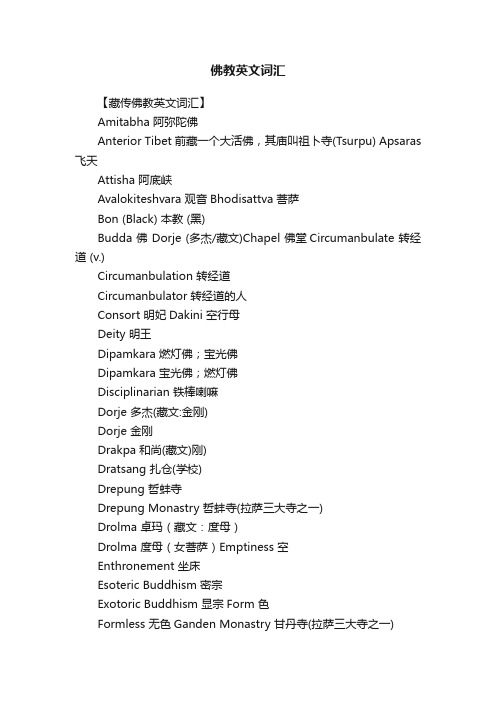
佛教英文词汇【藏传佛教英文词汇】Amitabha 阿弥陀佛Anterior Tibet 前藏一个大活佛,其庙叫祖卜寺(Tsurpu) Apsaras 飞天Attisha 阿底峡Avalokiteshvara 观音Bhodisattva 菩萨Bon (Black) 本教 (黑)Budda 佛 Dorje (多杰/藏文)Chapel 佛堂Circumanbulate 转经道 (v.)Circumanbulation 转经道Circumanbulator 转经道的人Consort 明妃Dakini 空行母Deity 明王Dipamkara 燃灯佛;宝光佛Dipamkara 宝光佛;燃灯佛Disciplinarian 铁棒喇嘛Dorje 多杰(藏文:金刚)Dorje 金刚Drakpa 和尚(藏文)刚)Dratsang 扎仓(学校)Drepung 哲蚌寺Drepung Monastry 哲蚌寺(拉萨三大寺之一)Drolma 卓玛(藏文:度母)Drolma 度母(女菩萨)Emptiness 空Enthronement 坐床Esoteric Buddhism 密宗Exotoric Buddhism 显宗Form 色Formless 无色Ganden Monastry 甘丹寺(拉萨三大寺之一)Ge-kor 铁棒喇嘛萨三大Great Perfection 大园满Green Tara 绿度母Gulug (Yellow hat) 格鲁派Guru 和沿(梵文)Hayagriva 马头明主Hinayana 小乘Holy mountain 魂山Hutukta 活佛(蒙文) (最好不要用)Incarnated lama 转世活佛Jampa 弥勒慈氏Jokhang Temple 大昭寺Kaggu (White) 噶举Kalachakra 时轮(金刚)Kangyur 甘珠尔(佛语)Karmapa 葛玛巴Khangtsen 康村(宿舍)Khatag 哈达Khenpo 堪布(主持)Kumbum 塔尔bKunbum M. 堪布寺(在西宁) Labrang M. 拉卜楞寺(甘南)Lama 喇嘛,指大和尚Lineage 传承Lobsang 洛桑Losang 洛桑Mahakala 大黑天(本教中神的名字) Mahayana 大乘Main Assembly Hall 大经堂Maitreya 弥勒慈氏Mandala 檀城Mandala 曼陀螺Manjushri 文殊(菩萨)Mantra 咒语Master 上师 (和尚)Material 色Medicine Buddha 药师佛Monastry 寺院(比Temple大)Monk 和尚( 小)Monlam 默然大法会Monlam 传昭大法会Mudra 手印Nga 阿Ngari 阿里Nirvan 涅盘Nyingma 宁玛Order 教派Padma 莲花Padmasambhava 莲花生Pagoda 佛塔Palkor Chode 白居寺Panchen Lama 班禅Partner 明妃Pelden Lhamo 吉祥天女Pelden Lhamo 班丹拉母Potala 布达拉宫Prayer meeting festival 传昭大法会Prayer wheel 传经筒Ramoche T emple 小昭寺Reincarnation 灵童Rinpoche 活佛(通用)Sakya (Stripe hat) 花派(萨迦) Sect 教派Sera Monastry 色拉寺(拉萨三大寺之一) Shakyamuni 施加摩尼Shantarakshita 寂护Shantarakshita 静命Sharipu 舍利子 (骨灰)Sku-Vbumchen-mo 白居寺Sontzen Gampo 松赞干布Soul mountain 魂山Soul yak 魂牛lStupa 灵塔pSutra Chanting Hall 大经堂aTaer 塔尔rTara 度母(女菩萨)Tashilhunpo Monastry 扎时伦布寺(在日喀泽)Temple 寺庙Tengyur 丹珠尔(论部)喀泽)Tibetan Buddhism 藏传佛教Tibetan Studies 藏学Tibetan Tripitaka 大藏经Tibetology 藏学Tradition 教派Trulku 活佛(藏文)Tsam-pa 糌粑Tsamba 糌粑Tsang 后藏Tsongkhapa 宗喀巴U 前藏Union of happiness 乐空双运Vajra 金刚Vajrayana 密宗White Tara 白度母Yamataka 阿曼德迦;大威Yamataka 怖畏金刚Yidam 本尊--------------------------------------------------------------------------------1. Lek Trima 妙绘赞2. Arya Tara 圣救度母3. Great Prayer Festival 传昭大法会4. Gongkhar 贡嘎5. Dolma Lhakhang 卓玛拉康6. Atisha 阿底峡尊者7. Yogi 瑜珈士8. Yogini 瑜珈女9. Vajrayogini 金刚瑜伽母那洛卡居空行母10.Prajna Paramita 般若波罗蜜多/doc/2810181545.html,hnisha Vijaya 尊胜佛母12.Norbu Lingka 罗布林卡寺13.Jokhang 大昭寺/doc/2810181545.html,dakh 拉达克/doc/2810181545.html,houl 拉荷16.Spitti 斯比忒17.Kinnaur 科努尔18.Sankrit 梵文19.Tantra Way 密法/密乘20.sang-gyey 桑结21.psychophysical aggregate 聚22.shakyamuni 释迦牟尼23.Sutra Way 显法/显乘24.nun 觉姆(尼姑)25.Dharma 佛法(法宝)26.Sangha 僧伽(僧宝)27.Buddhas 佛陀(佛宝)28.refuge 皈依29.dkon-mchog-gsum 贡却松(三宝)30.rtsa 扎31.rgyud32.lineage master 传承(上师)33.means 法门34.Yidam 本尊35.dakas 勇父36.dakinis 空行母37.meditation deities 观想主尊38.mandala deities 坛城主尊39.self-identification 自观40.Dharma 法41.Trisong Deutsen 藏王赤松德赞42.propitiate 供奉43.Dharmakaya 法身真身佛性44.Palden Lhamo 吉祥天母白拉日卓45.form 相46.Bikkshumi Lakshmi 比丘尼罗乞什密47.Vajra Dakas 金刚勇父48.Dharmapalas 护法49.Primordial 本初的50.awareness 觉性51.Arya Avalokiteshvara 观世音菩萨52.Tashi Jong 大吉镇53.Himachal Pradesh 喜马恰尔-布拉代什54.Drukpa kargyu 竹巴噶举55.invocation 祈祷56.epithet 尊号57.rGyal-bai-yum 诸佛之母58.Jina 耆那(梵语)59.mara 魔罗60.Tathagatas 如来61.Klesha(delusion)烦恼魔62.skandhas 蕴魔63.yama 死魔64.devaputra 天魔65.discourse 说法66.line 颂67.karma 因缘,业68.Three kayas 三身69.Samboghakaya 报身70.Nirmanakaya 应身71.transcendent buddha 胜义佛72.Asanga 无著大师73.emptiness 空性74.infinity 无生75.In Praise of the 108 Names of Arya Tara;hLa-mo-sgrol-mai-mtshan-brgya-rtsa-brgyad-pa 度母一百零八相释论76.prana 能量77.vayu 风神瓦尤78.samsara 轮回79.sentient being 有情众生80.abominable 魔89.Bodh Gaya 菩提伽耶90.Drom Tonpa 敦仲巴91.Chintachakra Tara 如意轮度母92.tsewang 长寿灌顶(次旺)93.public initiation 公开法会94.tantra 部95.Kriya 事部96.Vajra Dakinis 金刚空行母97.TAM 谭字98.AH 阿99.Om 嗡100.moon disk 月轮101.utpala 青莲花102.emerge 出定103.throne 法座104.mudra 手印105.mudra of supreme generosity 与愿印106.siddhi 证得悉地107.mahamudra 大印108.clairvoyance 千眼通109.mudra of bestowing refuge 皈依印110.hero/heroine posture 结半跏趺坐111.Amitabha 阿弥陀佛112.Padma family 莲花部113.charya 行部114.semi-wrathful 半怒相115.Kurukulle 作明佛母咕噜咕列佛母116.liturgy 礼拜117.Dolma Mandal Zhichok 度母四曼陀罗仪轨118.merit 功德119.Dharamsala 达兰萨拉120.Manjushri 文殊菩萨121.Vajrapani 金刚手菩萨123.Rigsum Gonpo 圣三部主124.ambrosia 不死的神肴不死的智慧125.iconography 造像126.peace 息127.increase 增127.power 怀(摄)128.wrath 诛(伏)129.Sakya 萨迦130.mahasiddha 大法师131.Virupa 毗卢婆132.Yamantaka 大威德金刚133.Hevajra 欢喜金刚134.yab-yum form 双身相父母尊135.Gelukpa 格鲁派136.Panchen 班禅137.Tashi Lhunpo 札什伦布寺138.buddha karma 佛业139.Vajradhara 金刚总持140.Dipamkara Shrijnana 吉祥燃灯智141.Perfection of Wisdom Sutra 般若波罗蜜多经142.Vajrabhairava 怖畏金刚143.Yamantaka 怖畏金刚大威德金刚144.Vajra Vetali 白达里空行母145.mudra of teaching 说法印146.mudra of meditation mudra 禅定印147.incarnation 转世148.emanation 化身149.Ling Tulkus 贝斯林祖古/doc/2810181545.html,pis lazuli 璧琉璃151.wishing jewel 许愿珠152.Rakta Yamari 怒尊甘露漩153.Yunten Dorjey Pal 仁钦南杰154.Buton Rinchen Drup 布顿仁钦朱155.exorcism 驱魔156.phurpa 普巴杵157.Zhalu 夏鲁158.Jonang 觉囊159.Bodong Chokley Namgyal 波东宁玛160.Mahakala 玛哈嘎拉(大黑天护法)161.pristine wisdom awareness 正净觉162.dharani 真言163.Parnashavari 叶衣佛母164.Shantideva 寂天165.secondary mindset 心所166.Three quintessential spiritual power 三善根(慈悲智慧信愿)学佛三要167.Sarma 沙玛(新译派)168.Terma Lineage 伏藏传承短传承岩传169.Karma Lineage 长传承教传170.Pure Vision Lineage 净观传承171.Sakya Trizin 萨迦天钦172.Karma Kargyu 噶玛噶举派173.Tai Situpa 大司徒174.Amritsar 阿姆利则175.vajra posture 结金刚印176.Padma Sambhava 莲花生大师177.sadhana 成就法178.heart chakra 心轮179.visualization 成就显现180.Marichi 具光佛母/光明佛母181.Ekajati 独髻佛母182.Om Amarani Sivandiye Soha 唵阿玛兰尼只温地易疏哈/doc/2810181545.html,mentary 释184.HRIH 赫利185.Siddharani 希达拉尼186.Siddhas 成就者187.Katmandu Valley 加德满都谷地188.Ashoka 阿育王189.stupa 佛塔190.Shigatsey 拉萨191.Chokhor Gyal 恰催寺192.mahasiddha Jetari 祇多梨193.Rechungpa 惹琼巴尊者/doc/2810181545.html,arepa 米勒日巴195.Marpa Lotsawa 玛尔巴译师196.Naropa 那洛巴197.Mahasiddha Tipupa 帝普巴大师198.Dharma Dodey 塔玛多德199.Amitayus-Hayagriva Combined 无量寿佛与马头明王合修法200.chulen 秋练201.chakra 静修202.Machik Labdon 成就之后/玛姬拉尊203.nine-deity mandala 九尊坛城204.four mindfulness 四正觉205.four miracle power 四神行206.Bhrama the Creator 梵天207.offering 供奉208.Namgyal Dratsang 尊胜扎仓209.Ganden Potrang of Drepung Monastery 哲蚌寺的甘丹宫210.Namgyalma Tong Cho 燃灯供佛,通促211.Namgyal Enclave 尊胜殿/doc/2810181545.html,hnisha Sita Tapatra 大白伞盖佛母213.Tsuktor Karmo 初妥卡嫫214.chakras 轮穴215.Panchen Sonam Drakpa 班禅索南扎巴216.padma 莲花217.Tathagata 如来218.lord of the family 部尊219.principal tantra 部主220.Akshobya 阿门佛金刚不动佛/doc/2810181545.html,hnisha kriyas 无垢佛顶222.nagas 龙族223.Drikung Kargyu 直贡噶举派224.Kalachakra 时轮节225.Tso Pema 莲师湖226.Drikung Chetsang Rinpochey 直贡澈赞仁波切227.mya ngan med pai shing 无忧树228.conventional wisdom 世间慧229.conventional reality 世俗谛230.Dayab 大雅231.Kham 康区232.Dravidian 德拉威233.Tenma Chunyi 丹玛女神丹玛久妮234.PAM 榜字235.Chogyal Pakpa 秋吉八思巴236.Kublai Khan 忽必烈237.Thirteen Golden Dharma 十三种金法238.Wanggi Lhamo 旺吉拉姆239.Vajrapanjara 金刚班札拉240.reality 本真,实相241.mudra of mandala offering 献曼陀罗手印242.Sakya Pandita 萨迦班智达243.Genghis Khan 成吉思汗244.Magzor Gyalmo 玛佐嘉摩245.Simhamukha 狮面空行佛母/森多玛246.Uddiyana 乌地亚那247.Kadam 噶当248.Samantabhadra 普贤王如来佛父/佛母;大日如来249.Khatvanga staff 骷髅杖250.Sherab Chamma 希然湛玛智慧251.Bonpo 苯教' 252.Tonpa Shenrab 敦巴辛饶253.Tazig 塔吉克254.zhang zhung 象雄255.Amdo 安多256.swastika 卍永恒不变之意257.ultimate reality 胜义有258.Sipai Gyalmo 思巴嘉摩259.Nairatmya 无我佛母260.liberation 解脱261.enlightment 证悟262.upaya 方便263.karmamudra 事业手印实女264.Kye-rim 生起次第265.Dzog-rim 圆满次第266.ambassador buddha 接引佛267.Nyang Tingzin Zangpo 那恩-登增桑布268.Guhyasamaja 密集金刚桑堆269.Sparshavajri 触摸金刚母270.Mamaki 玛玛齐佛母271.Gyumey 下密院举麦272.Gyuto 上密院举堆273.King Indrabhuit 奥利沙国王因陀罗浦谛274.Nagarjuna 龙树275.Goe Lotsawa 嘎大译师277.Tsongkhapa 宗喀巴278.Akshobhyavajra 密集不动金刚279.Vajrabhairava "大威德金刚/梵名""阎魔德迦"",藏语为""多吉久谢"",意为""怖畏金刚"",汉译大威德明王"280.Yama 阎魔护法289.Chamundi 伽蒙迪佛母290.vaishravana 毗沙门天财神护法291.Setrap Chen 护法292.Visvamata 流动回音293.Shambala 香巴拉,净土294.the Primordial Buddha 本初佛295.Clear Light 明光296.tong zuk 空相297.Visvamata 一切母298.Pandarika 潘达日卡299.Mahamaya 摩诃摩耶300.Chakrasamvara 胜乐金刚301.Vajravarahi 金刚亥母(Vajrayogini - Vajravarahi). 藏名译音: 多杰帕嫫(Dorje Pagmo).302.Luipa 鲁依巴303.Krishnacharya 坎哈304.Ghantapada 刚塔帕达305.Kailash 岗仁波齐峰306.Indus 印度河307.Ganges 恒河308.Brahmaputra 雅鲁藏布江309.Heruka 嘿噜嘎310.Chemchog Heruka 大殊胜嘿噜嘎311.Panjarnatha 怒相312.Vajrakila 普巴金刚/普巴多杰313.Triptachakra 洛格津母314.David Snellgrove 大卫?;施耐尔格罗夫315.Sakya Trizin 萨迦崔津法王316.Vajrakila dagger 普巴杵316.Mahayoga 大瑜伽317.Khon 昆氏传承318.system 法系319.Jamgon Kongtrul 蒋贡康楚320.Samya 桑耶寺321.Walchen Gekho 大密怒尊322.Lokbar Tsamey 洛巴查姆323.Sangwa Dragchen 先瓦324.Garuda 大鹏金翅鸟325.adibuddha 本初佛326.Tazig 塔吉克327.subtle energy 灵量328.Dravidian 达罗毗荼329.Aryan 雅利安330.Vishnu 毗湿奴331.Brahma 梵天332.bardo 中阴333.Sukkhasiddhi Lhamo 苏卡悉地?;拉姆334.visionary 幻像335.mahasiddhas 大成就者336.Tilopa 帝罗巴337.tummo 拙火338.Karmapa 噶玛巴339.meditation belt 禅修带340.Pamtingpa 帕丁巴341.Parping 帕平342.damaru "达玛鲁"343.Jamyang Khyentsey Wangpo 嘉央钦萨旺波344.abbot 修士345.vajrayana 金刚乘/doc/2810181545.html,m Drey 道果法347.instruction 教法要诀348.karmic connnection 业缘349.Dombi Heruka 东碧嘿鲁噶350.Sita Yogini 悉他瑜珈母351.Niguma 尼古玛352.Sukhasiddhi 丽严悉地353.curved knife 钺刀354.sharmapa 夏尔玛。
与宗教有关的单词
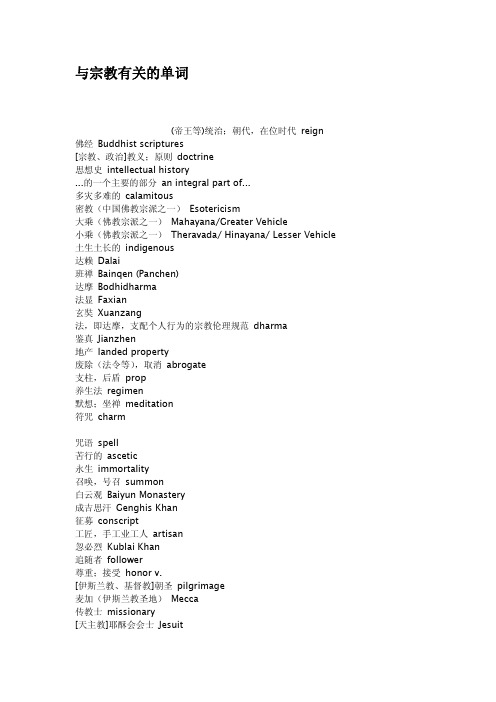
与宗教有关的单词(帝王等)统治;朝代,在位时代reign佛经Buddhist scriptures[宗教、政治]教义;原则doctrine思想史intellectual history...的一个主要的部分an integral part of...多灾多难的calamitous密教(中国佛教宗派之一)Esotericism大乘(佛教宗派之一)Mahayana/Greater Vehicle小乘(佛教宗派之一)Theravada/Hinayana/Lesser Vehicle 土生土长的indigenous达赖Dalai班禅Bainqen(Panchen)达摩Bodhidharma法显Faxian玄奘Xuanzang法,即达摩,支配个人行为的宗教伦理规范dharma鉴真Jianzhen地产landed property废除(法令等),取消abrogate支柱,后盾prop养生法regimen默想;坐禅meditation符咒charm咒语spell苦行的ascetic永生immortality召唤,号召summon白云观Baiyun Monastery成吉思汗Genghis Khan征募conscript工匠,手工业工人artisan忽必烈Kublai Khan追随者follower尊重;接受honor v.[伊斯兰教、基督教]朝圣pilgrimage麦加(伊斯兰教圣地)Mecca传教士missionary[天主教]耶酥会会士Jesuit利马窦Matteo Ricci礼部尚书Director of the Board of Rites历法calendar-study教团,修道会order使改变宗教或政治信仰、意见等proselyte使改变信仰;使皈依;使改信基督教convert v.n.(皈依者,改变信仰者)主管教区diocese[宗]安魂弥撒requiem mass大弥撒(有烧香、奏乐等)high mass小弥撒(无烧香、奏乐等)low mass教区;教区的全体居民parish教区居民parishioner[集合词]教士;牧师(天主教神职人员,新教教职人员的统称)clergy 教士,牧师clergyman[集合词](与教士、僧侣等相对的)俗人laity传播福音的evangelistic金陵协和神学院Nanjing Union Theological Seminary[法]规定;条款provision入教仪式admittance rites布达拉宫Potala Palace人民代表deputy to the People's Congress(学术)讨论会、座谈会symposiumChristianity基督教Christendom基督教界Catholicism天主教Protestantism新教,耶稣教Reformation宗教改革Lutheranism路德宗,信义宗Calvinism加尔文宗,长老宗Anabaptism再洗礼派Methodism卫斯理宗,卫理公会Puritanism清教主义Quakerism贵格会Judaism犹太教Islamism伊斯兰教Brahmanism,Brahminism婆罗门教Buddhism佛教Daoism道教paganism异端fetishism拜物教回答者:nxlbill-大魔法师八级12-1916:53佛教Buddhism释迦牟尼Sakyamuni佛寺Buddhist temple大雄宝殿the Great Buddha's Hall藏经楼depositary of Buddhist texts金刚经Vajracchedika-sutra素菜馆vegetarian restaurant罗汉堂arhat hall观音Guanyin;Goddess of Mercy;Avalokitesvara地藏God of Earth四大金刚Four Heavenly Guardians(at the entrance to a Buddhism temple); Four Devarajas四大天王Four Heavenly Kings因果报应karma藏传佛教Lamaism大藏经Tripitaka转世灵童reincarnated soul boy喇嘛庙lamasery道教Taoism道观Taoist temple道士Taist priest关帝庙temple of Lord Guan儒教Confucianism孔子庙Confucian temple孔子Confucius义、礼、智、信、忠、恕、孝、悌rightness,propriety,wisdom,trustworthiness, loyalty,reciprocity,filial piety,brotherly love禅宗Zen Buddhism不立别传,不立文字,直指人心,见性成佛。
常用佛教名词英语翻译
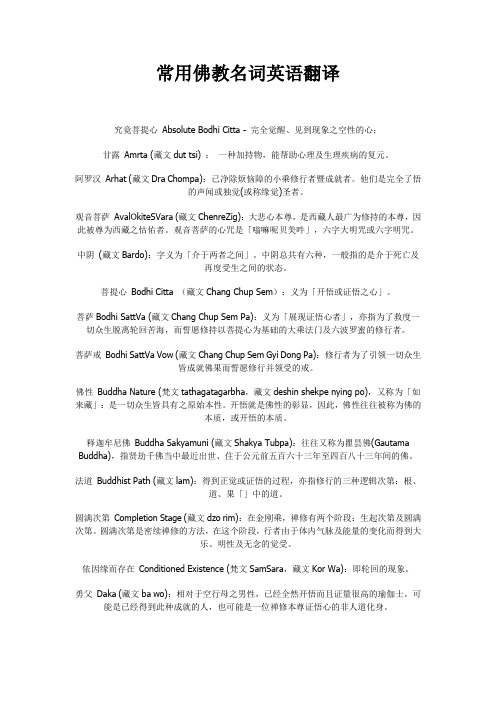
常用佛教名词英语翻译究竟菩提心Absolute Bodhi Citta - 完全觉醒、见到现象之空性的心;甘露Amrta (藏文dut tsi) :一种加持物,能帮助心理及生理疾病的复元。
阿罗汉Arhat (藏文Dra Chompa):已净除烦恼障的小乘修行者暨成就者。
他们是完全了悟的声闻或独觉(或称缘觉)圣者。
观音菩萨AvalOkiteSVara (藏文ChenreZig):大悲心本尊,是西藏人最广为修持的本尊,因此被尊为西藏之怙佑者。
观音菩萨的心咒是「嗡嘛呢贝美吽」,六字大明咒或六字明咒。
中阴(藏文Bardo):字义为「介于两者之间」。
中阴总共有六种,一般指的是介于死亡及再度受生之间的状态。
菩提心Bodhi Citta (藏文Chang Chup Sem):义为「开悟或证悟之心」。
菩萨Bodhi SattVa (藏文Chang Chup Sem Pa):义为「展现证悟心者」,亦指为了救度一切众生脱离轮回苦海,而誓愿修持以菩提心为基础的大乘法门及六波罗蜜的修行者。
菩萨戒Bodhi SattVa Vow (藏文Chang Chup Sem Gyi Dong Pa):修行者为了引领一切众生皆成就佛果而誓愿修行并领受的戒。
佛性Buddha Nature (梵文tathagatagarbha,藏文deshin shekpe nying po),又称为「如来藏」:是一切众生皆具有之原始本性。
开悟就是佛性的彰显,因此,佛性往往被称为佛的本质,或开悟的本质。
释迦牟尼佛Buddha Sakyamuni (藏文Shakya Tubpa):往往又称为瞿昙佛(Gautama Buddha),指贤劫千佛当中最近出世、住于公元前五百六十三年至四百八十三年间的佛。
法道Buddhist Path (藏文lam):得到正觉或证悟的过程,亦指修行的三种逻辑次第;根、道、果「」中的道。
圆满次第Completion Stage (藏文dzo rim):在金刚乘,禅修有两个阶段:生起次第及圆满次第。
佛教词汇

佛教буддизм ;буддийская религия释教буддуизм上乘(即大乘)Махаяна下乘(即小乘)Хинаяна大乘Махаяна;Большая колесница ;Широкий путь спасения小乘Хинаяна ;Малая колесница ;Узкий путь спасения瑜伽宗секта Егакара天台宗секта Тяньтай禅宗секта Чань喇嘛教ламаистский монастырь(храм)喇嘛庙ламаист(ламаит)喇嘛教徒желтая секта ламаизма黄教красная секта ламаизма红教белая секта ламаизма白教Шакья-Муни释迦牟尼Будда佛("佛陀"的简称)Будда如来(释迦牟尼的称号)Будда Татагата阿弥陀佛амитафо ;амитабу ;амитаба菩萨бодисатва罗汉Алохань阿罗汉Алохань三昧секрет ;суть ;сокровенный смысл四大четыре элемента ;земля,вода,огонь,воздух弥陀Амитаба观音(即"观世音")богиня Милосердия ;бодисатва观音菩萨бодисатва Гуаньинь弥勒Будда Мартейя韦驮Веда金刚Бог-хранитель ;божество-хранитель达摩бодидхарма阎罗Ямараджа-владыка ада阎王властитель ада Яньван;владыка ада阎王殿дворец владыки ада玄奘Танский монах Сюаньцзан鉴真Дзиянчжэнь经канон ;сутра佛经буддийский канон;полное собрание буддийских канон经藏сутра-питака藏经буддийский канон ;полное собрание буддийских канонов三藏经трипитака释部сборник буддийских канонов ;сутры释门буддизм金刚经сутра бога-хранителя法华经сутра дхарма佛学буддизм三宝три сокровищницы буддизма(Будда,его учение и его ученики)法учение ;правила佛法буддийское учение佛教主义правила буддизма佛的法力чудотворства Будды真谛истина四谛четыре истины буддизма清规заповедь戒规наставления清规戒律заповеди и обеты禅(意为静思)созерцание禅(泛指一切佛教事物)буддийский禅定Диана ;погружаться в созерцание坐禅погружаться в созерцание参禅созерцание(у буддистов)禅机откровение(у буддистов)禅心созерцание禅悟пробуждение ;постижение истины入定погрузиться в созерцание菩提Буди菩提树фикус благочестивый圆寂паринирвана入灭погружаться в нирвану解脱спастись ;спасение души自在свобода разума空пустота四大皆空суета сует ;мирская суета空门монашество遁入空门принять монашество法门путь к буддизму慈悲милосердие劫мировой период(=4320 млн.лет)三乘три пути спасения业деяние六欲шесть плотских страстей因缘причина缘причинная связь缘分судьба夙缘(宿缘)заветное желание结缘связаться с кем孽因грех因果报应карма ;возмездие六根уесть органов чувств :глаз,ухо,нос,язык,тело,разм德行(善行)добродетель ;добрый поступок功德доброе дело阴功тайное дело善добро恶зло造孽грех报应возмездие前世(前生)предыдущая жизнь今生настояцая жизнь来世загробная жизнь来世报应说возмездие ;воздаяние ;кара大千世界вселенная ;мир极乐世界рай ;эдем西天рай ;тот свет净土рай法眼око Будды慧眼прозорливость ;острый глаз超度молебствие(панихида)по умершему慈航путь спасения苦海юдоль скорби海苦无边безбрежное море мук彼岸тот свет ;нирвана转生перерождение ;переселение душ浊世мир земной凡尘мирской ;земной下凡сойти с неба ;спуститься из рая на землю下界дольный мир看破红尘постичь бренность жизни黄泉загробный(потусторонний)мир阴间(阴曹地府)царство теней梵брама梵文санскрит寺院монастырь僧院буддийский храм梵刹буддийский монастырь古刹древний монастырь兰若(佛寺)буддийский монастырь阿兰若скромное жилище庙храм ;кумирня禅林(буддийский)храм庵(尼庵)женский монастырь大殿главный зал(в храме)禅堂помещение в храме禅房жилище в храме藏经阁хранилище буддийских канонов神坛гробница ;святыня ;рака方丈настоятель(буддийского храма) ;аббат(обычного храма)住持настоятель(монастыря)知客буддийский церемонимейстер僧монах高僧возвышенный монах僧尼монахи и монахини僧俗монахи и миряне僧师буддийский монах和尚монах沙门(桑门)бонзы ;буддийский монахи比丘(俗称"和尚")бонза ;буддийский монах比丘尼(俗称"尼姑")буддистка-монахиня沙弥послушник尼(尼姑)монахиня头陀бродячий монах行脚僧странствующий монах托钵僧дервиш法师святой ;бонза居士последователь буддизма,не принявший пострижения ;буддист活佛живой Будда喇嘛лама皈依исповедовать что ;поклоняться кому剃度постриг戒епитимья ;умерщвление плоти受戒принятие обета取经паломничество за священными книгами化缘собирать пожертвования ;проситт подаяния布施подавать милостыню施主жертвователь檀越(即"施主")благодетель ;жертвователь合十сложить ладони(в знак приветствия)浴佛舍Праздник купания Будды舍利прах舍利塔ступа宝塔пагода浮屠пагода七级浮屠семиярусная пагода衣钵наследие;регалии袈裟ряса钵миска ;чаша戒刀монаший нож锡杖монаший посох念珠четки法器музыкальные инструменты буддийского богослужения蒲团круглая подстилка法号монашеское имя坐化смерть打坐сидеть,положив ногу на ногу膜拜класть поклоны念经читать сутру苦修подвижничество舍身пожертвовать собой显灵явление духа现身说法аоказать на личном примере佛像光轮нимб ;сияние;орело南无Намо香курительные свечи烧香возджигать курительные свечи香火фимиам香炉курильница香客паломник ;странник朝山进香паломничать по монастырям还顾жертвоприношение по обету清斋поститься斋期великопостный开斋разговляться斋饭постная пица斋戒поститься斋戒日постный день斋戒沐浴пост и омовение吃斋есть постное长斋(пожизненный)пост素овощной素食主义вегетарианство素食主义者вегетарианец世界佛教徒联谊会Всемирное содружество буддистов。
佛教英语

常见佛教英语佛教Buddhism三大语系佛教Three languages of Buddhism:汉语系佛教Chinese Language Buddhism藏语系佛教Tibetan Language Buddhism巴利语系佛教Pali Language Buddhism大乘佛教Mahayana Buddhism上座部佛教Theravada Buddhism金刚乘/密宗Vajrayana Buddhism(Lamaism) 中国佛教Chinese Buddhism佛经Sutra经、律、论Sutras, Vinaya, Sastra大藏经Tripitaka Sutra三宝(佛、法、僧)Triratna (Buddha, Dharma,Sangha)“三宝”加被May “Triratna”bless法师Master/Venerable长老Thero/Venerable大长老Mahathero/ Most Venerable方丈/主持Abbot佛教宗派Buddhist School佛教仪式:Buddhist Ceremony/Buddhist Service for和平祈祷法会Buddhist Praying Ceremony for World Peace礼佛pay respect for Buddha颂经Sutra Chanting香炉Incense burner上香To offer incense to Buddha因果Cause and effect成道/成佛To obtain the Buddha-hood觉悟To get enlightenment三皈五戒The ceremony for lay Buddhists to go to the Buddha for refuge, go to the Dharma for refuge, go to the Sangha for refuge and to follow the five commandments of Buddhism(no killing,no stealing,no sexual misconduct,no lying,no intoxicant)诸恶莫做,众善奉行,自净其意,既是佛教“To do no evil, to do only good, to purify the will, is thedoctrine of all Buddhas”做功德To make contribution to普渡终生To save all living beings from sufferings四谛Four noble truths八正道Eight noble paths善哉Sadhu (good or excellent)佛教寺院Monastery/Buddhist Temple山门The Front Gate大雄宝殿The Main Shrine Hall圆通殿The Hall of Universal Understanding 观音殿The Hall of Avalokitesvara Buddhisatva藏经阁The Tripitaka Sutra Pavilion罗汉堂The Hall of Arhan祖师殿The Hall of Patriarch四大天王Four deva-kings, the protectors of Buddhism韦驮Vitasoka/Vigatasoka, the protector of Buddhism斋堂Monastic Dinning Hall客堂Monastic Reception四大名山:Four holy mountains of Chinese Buddhism五台山Wutai Mountain is the Holy Place of Manjusri Buddhisattva峨嵋山Ermei Mountain is the Holy Place of Mahasthama Buddhisattva九华山Jiuhua Mountain is the holy place of Ksitigarbha Buddhisattva普陀山Putuo Mountain is the holy place of Avalokitesvara Buddhisattva佛像Buddha statue释迦牟尼佛Shakyamuni Buddha弥勒佛Maitreya Buddha迦叶佛Kasyapa Buddha阿弥陀佛Amitaba Buddha毗庐舍那佛Vairocana Buddha药师佛Bhaisajya Buddha/medicine Buddha 三世佛Buddhas of Three Periods: Kasyapa Buddha of the past Shakyamuni Buddha of the present, Maitrya Buddha of the future菩萨Buddhisattva观世音菩萨Avalokitesvara Buddhisattva菩贤菩萨Samandhabatra Buddhisattva大势智菩萨Mahasthamaprapta Buddhisattva文殊菩萨Manjusri Buddisattva地藏菩萨ksitigahba Buddhisattva善财童子Sudhana罗汉Arhan西方三圣:阿弥陀佛、观音菩萨、大势至菩萨Amitaba BuddhaAvalokitesvara Buddhisattva Mahasthamaprapta Buddhisattva达摩Budhidharma摩腾Kasyapa Matanga竺法兰Gobharana/Dharmaraksa佛学院Buddhist College僧伽Sangha僧、尼(比丘、比丘尼)monk、nun /Bhiksu, Bhiksuni方丈/主持Abbot首座Chief monk监院/当家Monastic Manger侍者Assistant中国佛教协会The Buddhist Association of China中国佛学院The Buddhist Academy of China会长President副会长Vice President秘书长Secretary General副秘书长Deputy Secretary General佛学英语词汇the Great Vehicle d大乘the Lesser Vehicle 小乘the Diamond Vehicle 金刚乘Four Noble Truths 四圣谛苦suffering集causes of suffering灭suppression of suffering道path to suppression of suffering Twelve Links in the Chain of Causation 十二因缘cycle of rebirths 轮回ignorance 惑nirvana 涅磐greed 贪hatred 嗔stupidity 痴pride 慢hesitation 疑wrong view 恶见no-soul 无我impermanence 无常sentient beings 众生deva 天human 人asura 阿修罗animal 畜牲hungry ghost 饿鬼denizen of hell 地狱morality 戒concentration 定wisdom 慧action 身speech 口consciousness 意lay Buddhists 居士novice monks 沙弥monks 比丘Five Precepts 五戒personal enlightenment 自觉universal enlightenment 觉他full enlightenment 觉满Buddha of Medicine 药师佛Buddha Maitreya 弥勒佛body of essence 法身award body 报身body of transformation 化身Four Heavenly Kings 四天王karma 因果Buddha Amitaba 阿弥陀佛Buddha of Sunlight (法身佛)毗卢遮那佛Buddha Sakyamuni 释迦牟尼佛Bodhisattva of Compassion 观音菩萨Boohisattva of Ultimate Knowledge 文殊菩萨Bodhisattva of Universal Benevolence 普贤菩萨Bodhisattva of Great Power 大势至菩萨bodhi 菩提dhyana 禅那sangha 僧团saha 娑婆五蕴five aggregates色aggregate of material body受aggregate of feelings想aggregate of perceptions行aggregate of predispositions识aggregate of consciousness简单佛学英语Birth is suffering; aging is suffering;生是苦;老是苦;sickness is suffering; death is suffering;病是苦;死是苦;association with the unpleasant is suffering; 怨憎会是苦;dissociation from the pleasant is suffering;爱别离是苦;not to get what one wants is suffering;求不得是苦;in short, attachment to the five aggregates is suffering.简言之,对五蕴的执取就是苦。
[汇总]常用宗教英语词汇
![[汇总]常用宗教英语词汇](https://img.taocdn.com/s3/m/f7a23ad188eb172ded630b1c59eef8c75fbf95ce.png)
常用宗教英语词汇1. Religious sect 教派Christianity 基督宗教,广义基督教(包括天主教、东正教、新教三大主要派别,以及其他一些影响较小的派別)Christendom 基督教界Catholicism 天主教Eastern Orthodox Church 东正教Protestantism 新教,耶稣教Evangelism 福音派Lutheranism 路德宗,信义宗Calvinism 加尔文宗,长老宗Anabaptism 再洗礼派Methodism 卫斯理宗,卫理公会Puritanism 清教主义Quakerism 贵格会Presbyterian 长老派教会Fetishism 拜物教Buddhism 佛教Zen 禅宗Lamaism 喇嘛教Esotericism 密宗MahayanaGreater Vehicle大乘(佛教宗派之一)TheravadaHinayanaLesser Vehicle小乘(佛教宗派之一)Daoism 道教Judaism 犹太教Islamism Islam 伊斯兰教Brahmanism, Brahminism 婆罗门教Shamanism 萨满教Confucianism 儒家思想Filial piety 孝道Paganism 异端Fetishism 拜物教2.建筑abbey大修道院,大教堂basilica 大教堂cathedral 教堂,主教座堂(天主教)church教堂,礼拜堂(基督教)chapel小教堂collegiate church 牧师会主持的教堂sanctuary 圣所,神殿convent,nunnery 女修道院monastery, cloister 修道院hermitage 偏僻的寺院seminary 神学院synagogue犹太教堂temple庙宇寺(佛、道教)pagoda塔,佛塔monastery 寺院Buddhist nunnery 庵lamasery 喇嘛庙mosque清真寺Mecca 麦加(伊斯兰教圣地)the Holy Land 圣地(指巴勒斯坦)the Holy City(Jerusalem, Rome, Mecca) 圣地(指耶路撒冷、罗马、麦加等地)3.教堂建筑细部high altar 祭坛nave 教堂中殿transept 教堂的十字型翼部holy-water basin 圣水池pulpit 讲道台stained glass window 彩色玻璃窗rose window 圆花窗fresco 壁画shrine 神殿(祠)altar 祭圣坛;圣餐台cross 十字架icon 圣像monstrance 圣体匣tabernacle 圣体龛ciborium, pyx 圣体容器,圣饼盒chalice 圣杯font 洗礼池aspergillum 圣水掸酒器Rosary 念珠censer, thurible 香炉holy-water basin 圣水池pulpit 讲道台stained glass window 彩色玻璃窗rose window 圆花窗fresco 壁画pagoda 塔,佛塔4.教义doctrine [宗教、政治]教义;原则the Bible 圣经the Old Testament 旧约the New Testament 新约the Gospel 福音provision [法]规定;条款buddhist scriptures 佛经(统称)the Koran 古兰经(伊斯兰教)the Talmud 犹太法典5.称呼God, the Lord 上帝the Father 圣父(三位一体之一者)the Son (of God) 圣子(指耶酥,三位一体之一者)the Holy Ghost; the Holy Spirit 圣灵(三位一体之一者)Jesus Christ 耶酥基督Christian 基督教徒Catholic 天主教徒Protestant 新耶酥教徒clergyman 教士、牧师Pope,the Holy Father ,pontiff 教皇cardinal 红衣主教archbishop 大主教bishop 主教priest 神父神甫(天主教)nun 修女(天主教)pastor, minister 牧师(新教)missionary 传教士 [集合词]教士;clergy 教士,牧师clergyman [集合词]牧师(天主教神职人员,新教教职人员的统称)laity (与教士、僧侣等相对的)俗人The Archbishop of Canterbury 坎特伯雷大主教,英国国教的教主,英国国教的两大主教之一the Archbishop of York 约克大主教,英国国教的两大主教之一,英国国教的付教主Monsignor 大人,阁下(天主教牧师荣誉头衔)diocese 主管教区parish 教区;教区的全体居民parishioner 教区居民following 追随者believer; follower 信徒Matteo Ricci 利马窦Buddhist 佛教徒Buddhist monk 和尚buddhist nun 尼姑Taoist priest 道士Taoist nun 道姑Bodhidharma 达摩dharma 法,即达摩,支配个人行为的宗教伦理规范Sakyamuni 释迦牟尼Tathagata 如来Buddha 佛陀Bodhisattva; Buddha; Buddhist idol 菩萨the Guanyin Bodhisatta; Avalokitesvara; the Goddess of Mercy 观音菩萨Maitreya 弥勒Jianzhen 鉴真Faxian 法显Xuanzang 玄奘Dalai 达赖Bainqen(Panchen) 班禅lama 喇嘛Living Buddha 活佛Allah 安拉;真主Muslim; Moslem 穆斯林ahung, imam 阿訇6.宗教仪式,活动religious rites; ritual 宗教仪式baptism 洗礼to receive baptism; to be baptized 受洗confession 忏悔Holy Communion 圣餐religious service 宗教仪式,礼拜to attend religious service; to go to church 做礼拜to attend Mass 做弥撒Sunday-school; Sabbath-school 主日学(星期日学校)sermon 讲道to preach; to deliver a sermon 传教,传道to do missionary work(基督教)传教choir 唱诗班mass 弥撒High Mass 大弥撒sung mass 唱诗弥撒Low Mass 诵经弥撒requiem mass [宗]安魂弥撒vespers 夕祷litany 连祷sermon 讲经psalm 圣诗canticle 赞美诗Via Crucis, Way of the Cross 十字架路,耶稣赴难路procession 宗教游行pilgrimage [伊斯兰教、基督教]朝圣admittance rites入教仪式meditation默想;坐禅regimen养生法charm符咒spell咒语to recitechant sutrasscriptures念经to chant the name of,to pray to Buddha念佛to burn joss-stick(s)(before an idol); to burn incense烧香procession 宗教游行Rosary 念珠。
佛教简介及万有因果律
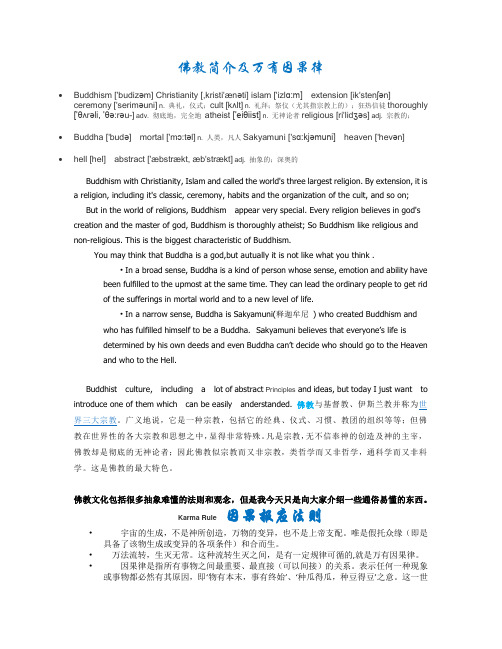
佛教简介及万有因果律∙Buddhism ['budizəm] Christianity [,kristi'ænəti] islam ['izlɑ:m] extension [ik'stenʃən] ceremony ['seriməuni] n. 典礼,仪式;cult [kʌlt]n. 礼拜;祭仪(尤其指宗教上的);狂热信徒thoroughly ['θʌrəli, 'θə:rəu-]adv. 彻底地,完全地atheist ['eiθiist]n. 无神论者religious [ri'lidʒəs] adj. 宗教的;∙Buddha ['budə] mortal ['mɔ:təl]n. 人类,凡人Sakyamuni ['sɑ:kjəmuni]heaven ['hevən]∙hell [hel] abstract ['æbstrækt, æb'strækt]adj. 抽象的;深奥的Buddhism with Christianity, Islam and called the world's three largest religion. By extension, it isa religion, including it's classic, ceremony, habits and the organization of the cult, and so on;But in the world of religions, Buddhism appear very special. Every religion believes in god's creation and the master of god, Buddhism is thoroughly atheist; So Buddhism like religious and non-religious. This is the biggest characteristic of Buddhism.You may think that Buddha is a god,but autually it is not like what you think .•In a broad sense, Buddha is a kind of person whose sense, emotion and ability have been fulfilled to the upmost at the same time. They can lead the ordinary people to get ridof the sufferings in mortal world and to a new level of life.•In a narrow sense, Buddha is Sakyamuni(释迦牟尼) who created Buddhism and who has fulfilled himself to be a Buddha.Sakyamuni believes that everyone’s life isdetermined by his own deeds and even Buddha can’t decide who should go to the Heavenand who to the Hell.Buddhist culture, including a lot of abstract Principles and ideas, but today I just want to introduce one of them which can be easily anderstanded.佛教与基督教、伊斯兰教并称为世界三大宗教。
- 1、下载文档前请自行甄别文档内容的完整性,平台不提供额外的编辑、内容补充、找答案等附加服务。
- 2、"仅部分预览"的文档,不可在线预览部分如存在完整性等问题,可反馈申请退款(可完整预览的文档不适用该条件!)。
- 3、如文档侵犯您的权益,请联系客服反馈,我们会尽快为您处理(人工客服工作时间:9:00-18:30)。
Khandhas or Aggregates – These are the five groupings that comprise body and mind: form, feeling, memory, mental formations, and consciousness. Regular, non-enlightened human beings are deluded in believing that they are these khandas and have not realized the truth that there is no self.
智慧 – 佛教里所指的真正的智慧,不是智力上的知识,它经由直接的体验,如实看见事物的真相。这里是意味着至少看到身心三法印中的一项:无常(总是变化的),苦(不能持续),无我(不受控制的)。这在正文中已详细解释。
Mindfulness – Awareness of physical or mental phenomena. More specially, awareness of what the body is doing in real time, or recognizing what mental phenomena or behaviours have just arisen. Genuine mindfulness arises automatically as result of the practitioner’s ability to be aware of the body and to recognize mental phenomena when they arise.
现象 – 心理或身体现象。身体现象包括身体的运动,呼吸,身体的状态(行住坐卧)及诸如此类。心理现象指主要的心理状态,比如想、焦躁不安、或好奇、情绪、以及感觉,但本书中主要指只停留片刻的真实的自然心理状态。
Wisdom – True wisdom in Buddhism is not intellectual knowledge, but comes from seeing the truth of how things really are through direct experience. Here it implies seeing at least one of the Three Characteristics of body and mind: things are impermanent (always changing), unsatisfactory (they don’t persist), and they are non-self (not under control). This is be explained in details in the text.
2) The second most common usage is the mind as that which watches, is aware or knows. It is an easy way to denote the fifth khandha, consciousness, as to not make it seem too abstract of a concept (and to avoid confusion between it and the pure consciousness that is spoken of in new-age spiritual books). The mind that Luang Por Pramote speaks of here is the bare consciousness that is a rudimentary awareness allowing the experience of a phenomenon to occur. It arises and falls along with each phenomenon. As an example of this usage, Luang Por often says, “The body stands, walks, sits and lies down, and the mind is the watcher.”
烦恼 – 通常又指贪嗔痴,它们染污心或覆盖心,使心不纯净,不能如实看见事物。贪(渴望),嗔(害怕、生气、悲伤等),痴(不明白真理;缺乏智慧)。
Dhamma Practice – Both formal meditation and practice in daily life in conjunction with Buddhist teachings in order to gain wisdom, see things as they are and thus liberate from suffering.
心 – 在本书中,用作两种解释:
1) 最普通的用法是用在“身和心”这个短语中,比如:”我们必须对这身和心有正念”,在这里”身”代表的是五蕴中的第一个:色,而”心”则是包括了五蕴中后四蕴(又称之为 ”名”),即所有心理现象:受、想、行、识。
2) 第二用法是用作“观察者”, 它观察、觉知、知道。简单地说,它是指五蕴中的第五个蕴:识。不要把它看作为一个抽象的概念(避免与新时代的灵修书籍提到的“纯净的意识”相混淆)。隆波帕默在这里所提到的“单纯意识”是指一种初步的觉知,它允许经验现象的发生,并且它随每一现象的生灭而生灭。比如,隆波说:“身体行、住、坐、卧时,心是观察者,它观察身体的行、住、坐、卧。”
Glossary
词汇表
Defilements – Usually spoken of under the subheading of greed (desire), aversion (fear,anger,sadness,etc.) and delusion (ignorance of Truth; lack of wisdom), there are what taint or cloud the mind incessantly, making it impure and unable to see things as they are.
正念 – 对身体或心理现象的觉知。特别是指觉知当下的身体在做什么,或认出刚刚已发生的心理现象或心理活动。随着禅修者觉知身体现象及认出已生起的心理现象的能力提升,真正的正念会自动生起。
Nibbāna – Nirvana, enlightenment, the end of suffering, the eradiction of the defilements.
五蕴 – 构造身和心的五个集合:色、受、想、行、识。通常,没有涅槃的人错误地相信他们就是这五蕴,没有认识到无我的真相。
Mind – Mind is used in two main ways, to be deciphered by context.
1) The most common usage is the the term “body and mind” or in phrases such as “we must be mindful of this body and this mind”, where body represents the first khandha (“rūpa”) and mind is an inclusive term for the last four of the five khandhas (“nāma”) in which all mental phenomena can be grouped: feeling, memory, mental formations and (bare) consciousness.
禅修 – 有两种:正式的禅修和日常生活中禅修。依照佛陀的教导修行,以便获得智慧,如实看待事物,从而从苦中解脱。
Fabrication- Sankhara or mental formations. In this translation, fabrication is usually referring to unnoticed defilements coming in and creating our deluded sense of who we are and our make-believe situation. In some case, the meaning of fabrication is merely illusions created by thought.
涅槃 – 正觉,苦的止熄,烦恼彻底的根除。
Phenomena – Mental and physical phenomena. Physical phenomena include bodily movements, breathing, bodily positions (standing, sitting, lying down) and the like. Mental phenomena are primarily mental states, such as that of thinking, restlessness, or curiousity, emotions, and feeling, but are primarily called phenomena in this book as in their true nature, such states last only momentarily.
